The results reported in the April 2022 bank lending survey (BLS) relate to changes observed during the first quarter of 2022 and expectations for the second quarter of 2022. The survey was conducted between 7 March and 22 March 2022. A total of 151 banks were surveyed in this round, with a response rate of 100%. In addition to results for the euro area as a whole, this report also contains results for the four largest euro area countries.[1]
A number of ad hoc questions were included in the April 2022 survey. They address the impact of the situation in financial markets on banks’ access to retail and wholesale funding, the impact of the ECB’s asset purchase programmes (APP and PEPP), the impact of the ECB’s negative deposit facility rate and the ECB’s two-tier system, and the impact of TLTRO III on banks and their lending policies.
1 Overview of results
In the April 2022 BLS, euro area banks indicated a net tightening of credit standards on loans to enterprises in the first quarter of 2022. That is, the percentage share of banks reporting a tightening of credit standards was larger than the share of banks reporting an easing. Banks referred to perceptions of increased risk and decreased risk tolerance, in the context of high uncertainty, supply chain disruptions and high energy and input prices, as factors behind the net tightening of credit standards. For the second quarter of 2022, banks expect a considerably stronger net tightening of credit standards on loans to firms, likely reflecting the uncertain economic impact of the war in Ukraine and the anticipation of less accommodative monetary policy.
Banks indicated a continued net increase in loan demand from firms in the first quarter of 2022. Financing needs of firms for working capital had a strong positive impact on loan demand, reflecting higher working capital needs due to supply bottlenecks and increasing input costs as well as precautionary inventories and liquidity holdings. Fixed investment provided a positive contribution to loan demand, albeit more moderate than in the previous quarter. In the second quarter of 2022, banks expect a continued net increase in demand for loans to firms, driven by short-term loans.
Regarding credit standards for loans to households, banks reported a slight net tightening for housing loans in the first quarter of 2022 and a net easing for consumer credit. For housing loans, perceptions of higher risk and lower risk tolerance contributed to the net tightening, while the net easing for consumer credit was driven by increased risk tolerance on the part of banks. Loan demand from households increased, on balance, across loan categories in the first quarter of 2022. Housing loan demand was mainly supported by the low general level of interest rates, while durable goods consumption particularly contributed to the net increase in consumer credit demand. In the second quarter of 2022, banks expect a moderate net tightening of credit standards for all lending to households. In addition, banks expect a net decrease in housing loan demand and unchanged demand for consumer credit.
In more detail, euro area banks reported a net tightening of credit standards (i.e. banks’ internal guidelines or loan approval criteria) for loans or credit lines to enterprises in the first quarter of 2022 (net percentage of banks of 6%, after 2% in the fourth quarter of 2021; see Section 2) and expect a considerably stronger net tightening for the second quarter (21%). Banks referred to high uncertainty and a tightening impact from the general economic and firm-specific outlook on credit standards on loans to firms in the first quarter of 2022, following their overall benign view of firms’ credit risks in the fourth quarter of 2021. Banks are concerned about the impact of supply chain disruptions, high energy prices and other input costs, as well as corporate exposures to Russia, Ukraine and Belarus on firms’ credit risks. In this context, banks’ risk tolerance also declined moderately leading to a tightening impact on credit standards. The overall impact of banks’ cost of funds and balance sheet situation on their credit standards remained broadly neutral. This reflects on the one hand a small tightening contribution from banks’ funding costs, likely related to the rise in bank bond yields in the context of higher than expected inflation and expectations of less accommodative monetary policy, and on the other hand an easing contribution from banks’ liquidity position related to the still accommodative monetary policy.
In the second quarter of 2022, euro area banks expect a considerably stronger net tightening of credit standards for loans to firms (21%), against the background of the high uncertainty regarding the impact of the war in Ukraine on the economic outlook and firms’ credit risks. The anticipation of tighter monetary policy in the future is also likely to have played a role, as suggested by banks’ expectations regarding the impact of the ECB’s asset purchase programmes over the coming months (see Section 3). Compared with previous episodes, the expected net tightening of credit standards on loans to firms was similar to that observed in the July 2020 survey, at the height of the pandemic credit risk concerns, and before that in the January 2012 survey, as the euro area sovereign debt crisis intensified.
In the first quarter of 2022, euro area banks reported a slight net tightening of credit standards for housing loans (net percentage of banks of 2%, after 0% in the fourth quarter of 2021; see Section 3), and a continued net easing for consumer credit and other lending to households (-5%, after -4%), in line with expectations reported in the previous survey round. The net tightening for housing loans was driven by higher risk perceptions and slightly lower risk tolerance, while competition and cost of funds and balance sheet constraints had a broadly neutral impact. For consumer credit, increased risk tolerance mainly contributed to the net easing. Banks expect credit standards to tighten moderately for housing loans (8%) and for consumer credit (7%) in the second quarter of 2022.
Banks’ overall terms and conditions (i.e. banks’ actual terms and conditions agreed in the loan contract) for new loans to enterprises tightened somewhat in the first quarter of 2022 (net percentage of 3%, after 0%). This was mainly on account of a considerable widening of margins on riskier loans (net percentage of 12%; margins defined as the spread over relevant market reference rates), while margins on average loans widened moderately (net percentage of 4%). Banks reported a moderate net tightening of overall terms and conditions for housing loans (net percentage of 6%, after ‑1%). Overall terms and conditions for consumer credit and other lending to households eased slightly in net terms (-2%, after -1%), on account of narrower loan margins.
In the first quarter of 2022, banks reported, on balance, an increase in the share of rejected applications for loans to firms (net percentage of 4%, after 0%). For housing loans, euro area banks reported broadly no change in the share of rejected applications (1%, after 2%), while the share of rejected applications decreased slightly in net terms for consumer credit (-2%, after -3%).
Among the largest euro area countries, credit standards for loans to enterprises tightened in Germany, Spain and Italy, while these remained unchanged in France in the first quarter of 2022 (see Overview table). Credit standards for housing loans tightened in Germany, eased in Italy and remained unchanged in France and Spain. Credit standards for consumer credit and other lending to households eased in France and Italy and remained unchanged in Germany and Spain.
Firms’ net demand for loans continued to increase in the first quarter of 2022, according to banks (net percentage of 17%, after 18% in the fourth quarter of 2021; see Section 2). Loan demand continued to be driven by a strong positive impact of firms’ financing needs for working capital (net percentage of 16%) reflecting supply chain disruptions, as well as precautionary inventories and liquidity holdings in an environment of high uncertainty. The contribution of fixed investment to loan demand remained positive (net percentage of 9%) but moderated following the significant positive contribution in the previous quarter. Loan demand increased, in net terms, for long-term maturities – reflecting the continued economic recovery at the beginning of the year and expected increases in financing costs – and, to a smaller extent, for short-term maturities related to supply chain disruptions and the impact of the war. In addition, banks continued to report a positive impact on loan demand from the low general level of interest rates as well as other financing needs, which include mergers and acquisitions activity and debt refinancing and restructuring. In the second quarter of 2022, banks expect a continued net increase in demand for loans to firms (net percentage of 12%), due to stronger demand for short-term loans, while banks expect demand for long-term loans to decrease slightly in net terms.
In the first quarter of 2022, net loan demand from households increased further, both for housing loans (net percentage of 10%, after 8% in the fourth quarter of 2021; see Section 2) and for consumer credit (net percentage of 11%, after 2%). The net increase in housing loan demand was mainly driven by the general level of interest rates, in line with a narrowing of margins on average loans and possibly reflecting anticipation effects of the expected further increases in interest rates as bank funding costs rise. The positive net contribution of housing market prospects to loan demand decreased further compared with previous quarters. Demand for consumer credit was supported by durable consumption and – to a lesser extent – by consumer confidence in the first quarter, despite the sharp decline in consumer confidence recorded by the European Commission’s sentiment indicator in March 2022. For the second quarter of 2022, banks expect a net decrease in the demand for housing loans (-10%) and broadly unchanged demand for consumer credit (1%).
Banks reported a net increase in demand for loans to enterprises in Germany and France, while it remained unchanged according to banks in Spain and decreased in Italy in the first quarter of 2022 (see Overview table). Net demand for housing loans increased in Germany and Spain, remained unchanged in France and decreased in Italy. Demand for consumer credit increased in all four largest euro area countries.
Overview table
Latest BLS results for the largest euro area countries
(net percentages of banks reporting a tightening of credit standards or an increase in loan demand)
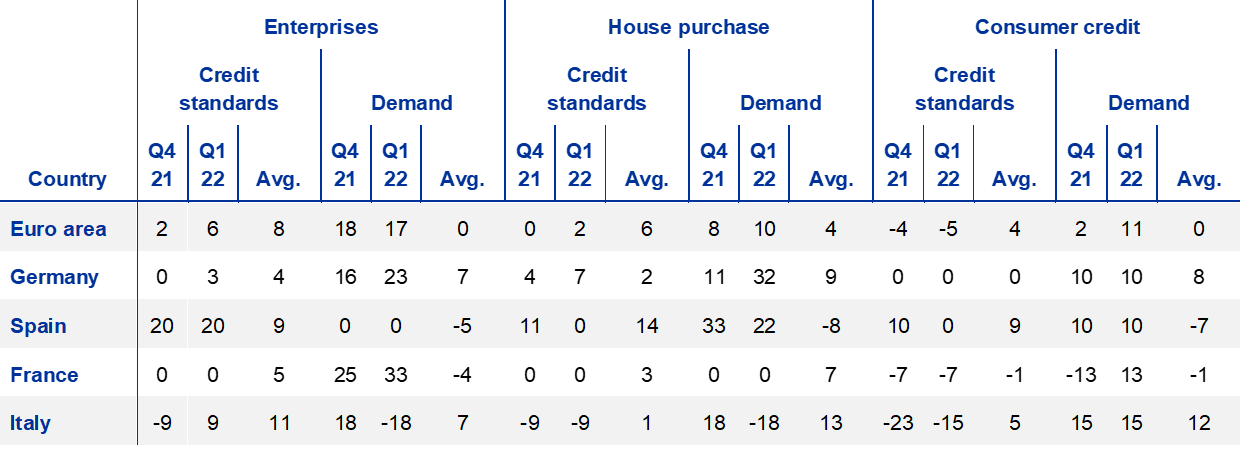
Notes: The “Avg.” columns contain historical averages, which are calculated over the period since the beginning of the survey, excluding the most recent round. Owing to the different sample sizes across countries, which broadly reflect the differences in the national shares in lending to the euro area non-financial private sector, the size and volatility of the net percentages cannot be directly compared across countries.
The April 2022 BLS also included a number of ad hoc questions. Regarding access to retail and wholesale funding, euro area banks reported that their access to money markets, securitisation and particularly debt securities deteriorated, in net terms, in the first quarter of 2022, reflecting the tightening of financial market conditions for banks. By contrast, access to retail funding remained broadly unchanged in the first quarter of 2022. In the second quarter of 2022, euro area banks expect a further deterioration of their access to market-based funding.
The ECB’s asset purchase programmes continued to have a positive net impact on banks’ liquidity position and market financing conditions over the past six months, but banks expect this to turn into a negative impact over the next six months. The expected deterioration is likely related to the envisaged scaling down of monetary policy accommodation, specifically the end of net asset purchases under the ECB’s pandemic emergency purchase programme (PEPP) in March 2022 and the reduction in the monthly net asset purchases under the ECB’s asset purchase programme (APP) over the next six months. Likewise, banks expect the net easing impact of the ECB’s asset purchase programmes on their credit standards and terms and conditions, which they reported mainly for loans to enterprises over the past six months, to turn into a limited net tightening impact over the coming six months. For lending volumes, the continued, albeit smaller, positive impact of the ECB’s net asset purchases on lending volumes to firms and households for house purchase over the past six months is expected to turn into a limited dampening impact over the coming six months for lending to firms. For lending to households, banks report a broadly neutral impact of the expected gradual normalisation of monetary policy accommodation.
Euro area banks reported, in net terms, that the ECB’s negative deposit facility rate (DFR) continued to contribute negatively to their profitability over the past six months. The DFR, on balance, reduced lending rates and had a positive impact on lending volumes for loans to firms and households. In addition, the DFR had a negative impact on deposit rates and a positive impact on non-interest rate charges on deposits from firms and households, indicating a continued pass-through of negative rates. Over the next six months, banks expect the impact of the DFR on lending and deposits to continue in the same direction but to become weaker. The two-tier system reportedly mitigated the negative impact of the DFR on bank profitability compared with a counterfactual situation without such a system, mainly via a positive impact on net interest income, while banks did not report any further impact on lending rates and deposit rates for firms and households.
Banks’ participation in the last operation of the TLTRO III programme in December 2021 was more limited compared with previous operations, in line with lower overall take-up of TLTRO III funds. Granting loans to the non-financial private sector remained the most common use of funds over the past six months, while profitability remained the most important reason for banks to participate in TLTRO III. In addition, a considerable fraction of banks reported holding TLTRO III liquidity with the Eurosystem. According to banks, TLTRO III continued to have a positive impact on their financial situation and lending volumes as well as a net easing impact on lending conditions for firms and households, implying a sustained positive impact of the large outstanding TLTRO liquidity despite the lower take-up in recent operations. Over the next six months, banks expect a further but more limited positive impact on their financial situation and lending volumes from TLTRO III and a more limited net easing impact on terms and conditions.
Box 1
General notes
The bank lending survey (BLS) is addressed to senior loan officers at a representative sample of euro area banks. In the current round, 151 banks were surveyed, representing all euro area countries and reflecting the characteristics of their respective national banking structures. The main purpose of the BLS is to enhance the Eurosystem’s knowledge of bank lending conditions in the euro area.[2]
BLS questionnaire
The BLS questionnaire contains 22 standard questions on past and expected future developments: 18 backward-looking questions and four forward-looking questions. In addition, it contains one open-ended question. Those questions focus on developments in loans to euro area residents (i.e. domestic and euro area cross-border loans) and distinguish between three loan categories: loans or credit lines to enterprises; loans to households for house purchase; and consumer credit and other lending to households. For all three categories, questions are asked about the credit standards applied to the approval of loans, the terms and conditions of new loans, loan demand, the factors affecting loan supply and demand conditions, and the percentage of loan applications that are rejected. Survey questions are generally phrased in terms of changes over the past three months or expected changes over the next three months. Survey participants are asked to indicate in a qualitative way the strength of any tightening or easing or the strength of any decrease or increase, reporting changes using the following five-point scale: (1) tightened/decreased considerably, (2) tightened/decreased somewhat, (3) basically no change, (4) eased/increased somewhat or (5) eased/increased considerably.
In addition to the standard questions, the BLS questionnaire may contain ad hoc questions on specific topics of interest. Whereas the standard questions cover a three-month time period, the ad hoc questions tend to refer to changes over a longer time period (e.g. over the past and next six months).
Aggregation of banks’ replies to national and euro area BLS results
The responses of the individual banks participating in the BLS are aggregated in two steps to form the euro area results. In the first step, the responses of individual banks are aggregated to national results for the euro area countries. In the second step, the national BLS results are aggregated to euro area BLS results.
In the first step, banks’ replies are aggregated to national BLS results for all countries by applying equal weights to all banks in the sample.[3] For two countries (Malta and Slovakia), national results are additionally aggregated by applying a weighting scheme based on the amounts outstanding of loans to non-financial corporations and households of the individual banks in the respective national samples.
In the second step, since the numbers of banks in the national samples differ considerably and do not always reflect those countries’ respective shares of lending to euro area non-financial corporations and households, the unweighted national survey results of all countries are aggregated to euro area BLS results by applying a weighting scheme based on the national shares of outstanding loans to euro area non-financial corporations and households.
BLS indicators
Responses to questions relating to credit standards are analysed in this report by looking at the difference (the “net percentage”) between the percentage of banks reporting that credit standards applied in the approval of loans have been tightened and the percentage of banks reporting that they have been eased. For all questions, the net percentage is determined on the basis of all participating banks that have business in or exposure to the respective loan categories (i.e. they are all included in the denominator when calculating the net percentage). This means that banks that specialise in certain loan categories (e.g. banks that only grant loans to enterprises) are only included in the aggregation for those categories. All other participating banks are included in the aggregation of all questions, even if a bank replies that a question is “not applicable” (“NA”). This harmonised aggregation method was introduced by the Eurosystem in the April 2018 BLS. It has been applied to all euro area and national BLS results in the current BLS questionnaire, including backdata.[4] The resulting revisions for the standard BLS questions have generally been small, but revisions for some ad hoc questions have been larger owing to a higher number of “not applicable” replies by banks.
A positive net percentage indicates that a larger proportion of banks have tightened credit standards (“net tightening”), whereas a negative net percentage indicates that a larger proportion of banks have eased credit standards (“net easing”).
Likewise, the term “net demand” refers to the difference between the percentage of banks reporting an increase in loan demand (i.e. an increase in bank loan financing needs) and the percentage of banks reporting a decline. Net demand will therefore be positive if a larger proportion of banks have reported an increase in loan demand, whereas negative net demand indicates that a larger proportion of banks have reported a decline in loan demand.
In the assessment of survey balances for the euro area, net percentages between -1 and +1 are generally referred to as “broadly unchanged”. For country results, net percentage changes are reported in a factual manner, as differing sample sizes across countries mean that the answers of individual banks have differing impacts on the magnitude of net percentage changes.
In addition to the “net percentage” indicator, the ECB also publishes an alternative measure of banks’ responses to questions relating to changes in credit standards and net demand. This measure is the weighted difference (“diffusion index”) between the percentage of banks reporting that credit standards have been tightened and the percentage of banks reporting that they have been eased. Likewise, as regards demand for loans, the diffusion index refers to the weighted difference between the percentage of banks reporting an increase in loan demand and the percentage of banks reporting a decline. The diffusion index is constructed in the following way: lenders who have answered “considerably” are given a weight (score of 1) which is twice as large as that given to lenders who have answered “somewhat” (score of 0.5). The interpretation of the diffusion indices follows the same logic as the interpretation of net percentages.
Detailed tables and charts based on the responses provided can be found in Annex 1 for the standard questions and Annex 2 for the ad hoc questions. In addition, BLS time series data are available on the ECB’s website via the Statistical Data Warehouse.
A copy of the questionnaire, a glossary of BLS terms and a BLS user guide with information on the BLS series keys can all be found on the ECB's website.
2 Developments in credit standards, terms and conditions, and net demand for loans in the euro area
2.1 Loans to enterprises
2.1.1 Credit standards for loans to enterprises tightened
Euro area banks reported a net tightening of credit standards (i.e. banks’ internal guidelines or loan approval criteria) for loans or credit lines to enterprises in the first quarter of 2022, i.e. the percentage share of banks reporting a tightening of credit standards was larger than the share of banks reporting an easing (net percentage of banks of 6%, after 2% in the fourth quarter of 2021; see Chart 1 and Overview table). While the net tightening remained slightly below the historical average (8%; see Overview table), banks had expected broadly unchanged credit standards in the previous quarter (-1%), as they were optimistic about the economic recovery from the pandemic. In the first quarter of 2022, credit standards tightened equally for loans to small and medium-sized enterprises (SMEs; 7%, after 2%) and large firms (7%, after -2%; see Chart 2). They tightened for both short-term loans (5%, after 0%) and for long-term loans (6%, after 0%).
Banks indicated a net tightening impact of increased risk perceptions and decreased risk tolerance in the first quarter of 2022 (see Chart 1 and Table 1). They referred to a tightening impact from the general economic and firm-specific outlook as well as from the war in Ukraine and the related uncertainty.[5] This follows their overall benign view of firms’ credit risks in the fourth quarter of 2021. Banks are concerned about the impact of supply chain disruptions, high energy and other input prices as well as corporate exposures to Russia, Ukraine and Belarus on firms’ credit risks. The overall impact of banks’ cost of funds and balance sheet situation on their credit standards remained broadly neutral. This reflects on the one hand a small tightening contribution from banks’ funding costs due to the rise in bank bond yields in the context of higher than expected inflation and changing monetary policy expectations, and on the other hand an easing contribution from banks’ liquidity situation in light of the still accommodative monetary policy. Banks indicated a similar assessment of the main drivers of credit standards on loans to SMEs and large firms (see Chart 2). For both, higher risk perceptions were the main contributor to the net tightening of credit standards in the first quarter of 2022.
Chart 1
Changes in credit standards applied to the approval of loans or credit lines to enterprises, and contributing factors
(net percentages of banks reporting a tightening of credit standards and contributing factors)
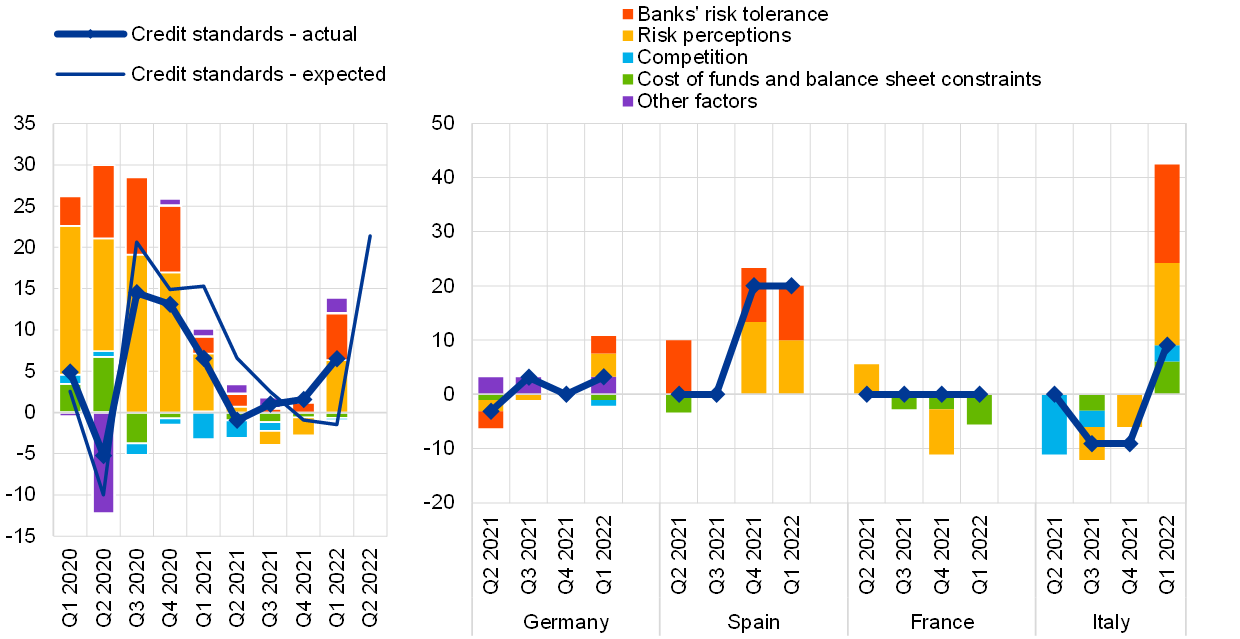
Notes: “Actual” values are changes that have occurred, while “expected” values are changes anticipated by banks. Net percentages are defined as the difference between the sum of the percentages of banks responding “tightened considerably” and “tightened somewhat” and the sum of the percentages of banks responding “eased somewhat” and “eased considerably”. The net percentages for responses to questions related to contributing factors are defined as the difference between the percentage of banks reporting that the given factor contributed to a tightening and the percentage reporting that it contributed to an easing. “Cost of funds and balance sheet constraints” is the unweighted average of “bank’s capital and the costs related to bank’s capital position”, “access to market financing” and “liquidity position”; “risk perceptions” is the unweighted average of “general economic situation and outlook”, “industry or firm-specific situation and outlook/borrower’s creditworthiness” and “risk related to the collateral demanded”; “competition” is the unweighted average of “competition from other banks”, “competition from non-banks” and “competition from market financing”. The net percentages for “other factors” refer to further factors which were mentioned by banks as having contributed to changes in credit standards.
Chart 2
Changes in credit standards applied to the approval of loans or credit lines to SMEs and large enterprises, and contributing factors
(net percentages of banks reporting a tightening of credit standards and contributing factors)
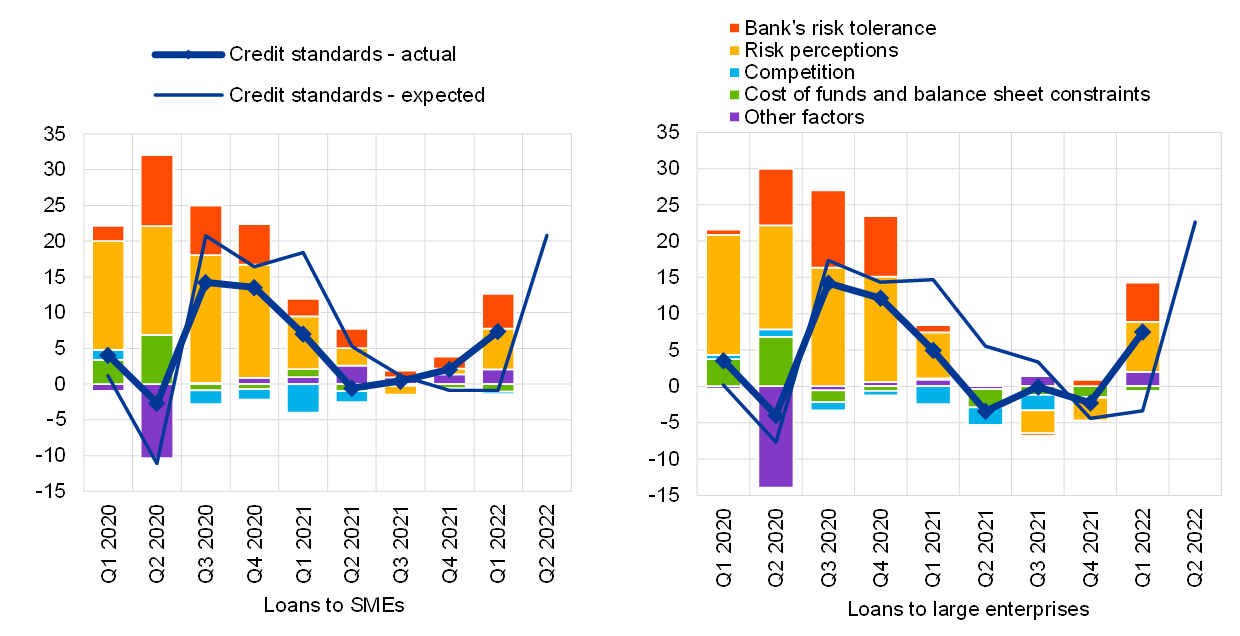
Note: See the notes on Chart 1.
In the largest euro area countries, credit standards for loans to enterprises tightened in Germany, Spain and Italy, while they remained unchanged in France in the first quarter of 2022. In Germany, Spain and Italy, higher risk perceptions and banks’ lower risk tolerance had a net tightening impact on credit standards, while these factors had a neutral impact in France. Banks’ funding cost and balance sheet position had a net easing impact in France, driven by banks’ favourable liquidity position, and a net tightening impact in Italy, owing to higher bank funding cost and a tightening impact of banks’ access to market financing in the first quarter of 2022.
In the second quarter of 2022, euro area banks expect credit standards for loans to firms to tighten considerably (net percentage of 21%), for both loans to SMEs (net percentage of 21%) and to large firms (net percentage of 23%), against the background of the high uncertainty regarding the impact of the war in Ukraine on the economic outlook and firms’ credit risks. In addition, the impact of the anticipated less accommodative monetary policy on banks’ cost of funds and balance sheet position likely played a role in banks’ expectations, as also suggested by banks’ indications on the impact of the ECB’s asset purchase programmes over the coming six months (see Section 3). Compared with previous episodes, the expected net tightening of credit standards on loans to firms was similar to that observed in the July 2020 survey, at the height of the pandemic credit risk concerns, and before that in the January 2012 survey, as the euro area sovereign debt crisis intensified.
Table 1
Factors contributing to changes in credit standards for loans or credit lines to enterprises
(net percentages of banks)

Note: See the notes on Chart 1.
2.1.2 Terms and conditions on loans to enterprises tightened somewhat
Banks’ overall terms and conditions (i.e. banks’ actual terms and conditions agreed in the loan contract) for new loans to enterprises tightened somewhat in the first quarter of 2022 (net percentage of 3%, after 0%; see Chart 3 and Table 2). This was mainly on account of a considerable widening of margins on riskier loans (net percentage of 12%; margins defined as the spread over relevant market reference rates), whereas margins on average loans widened moderately (net percentage of 4%). The wider loan margins are so far not yet reflected in firms’ overall broadly stable actual aggregate cost of bank borrowing at the euro area level, which is available until February 2022, although aggregate developments somewhat mask differences across countries (see below). Banks also reported somewhat stricter collateral requirements and higher non-interest charges, which contributed to the net tightening of overall terms and conditions for loans to firms, while there was a slight net easing impact from the size of loans or credit lines. Developments in overall terms and conditions and their components were similar for loans to SMEs and large firms in the first quarter of 2022 (see Chart 4).
Chart 3
Changes in terms and conditions on loans or credit lines to enterprises
(net percentages of banks reporting a tightening of terms and conditions)
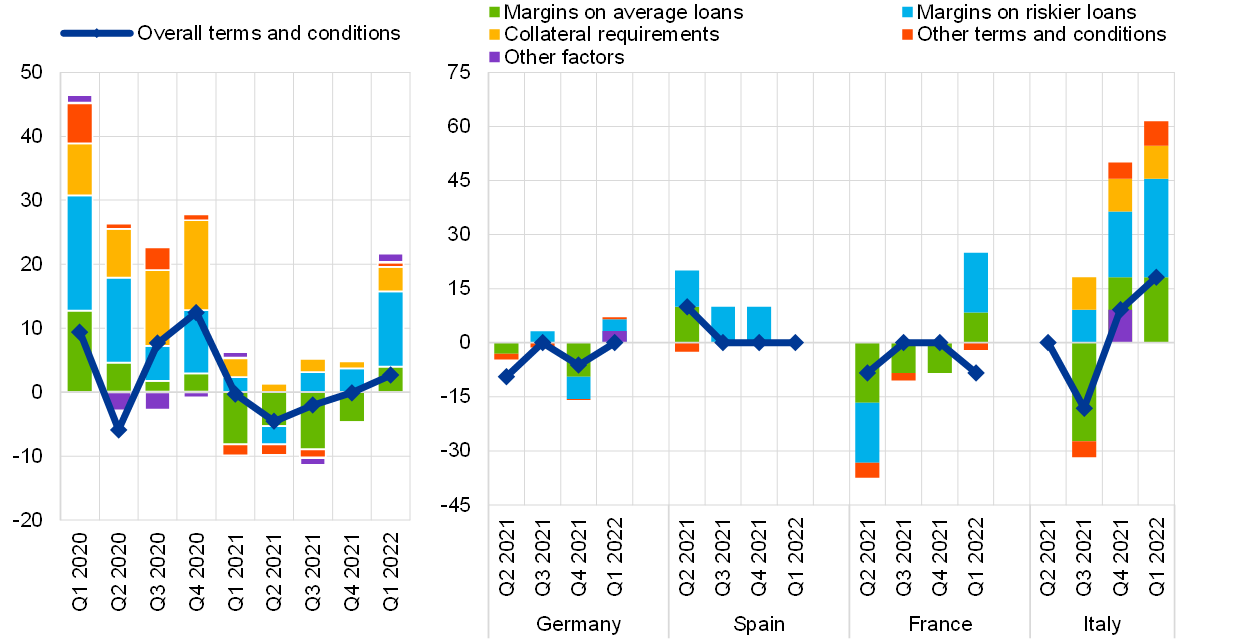
Notes: “Margins” are defined as the spread over a relevant market reference rate. “Other terms and conditions” is the unweighted average of “non-interest rate charges”, “size of the loan or credit line”, “loan covenants” and “maturity”. The net percentages for “other factors” refer to further factors which were mentioned by banks as having contributed to changes in terms and conditions.
Chart 4
Changes in terms and conditions on loans or credit lines to SMEs and large enterprises
(net percentages of banks reporting a tightening of terms and conditions)
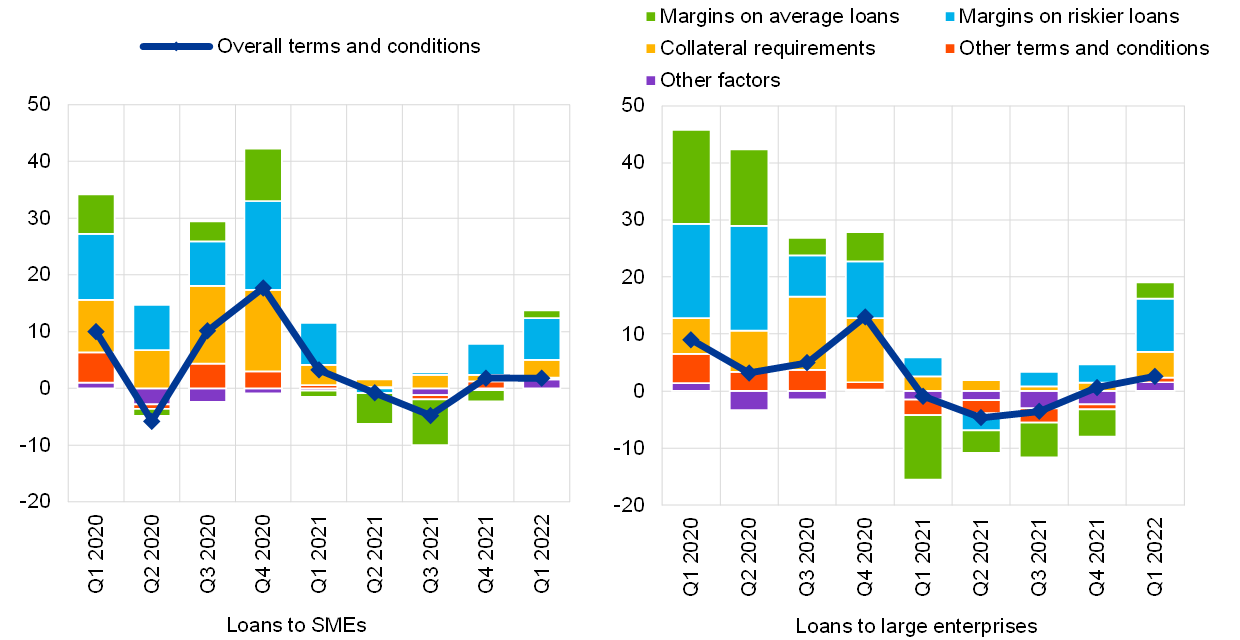
Note: See the notes on Chart 3.
Banks’ higher capital costs and higher risk perceptions were the main drivers of the net tightening of overall terms and conditions for loans to firms in the first quarter of 2022 (see Table 3). Banks indicated a net tightening impact of their capital costs, reflecting the adverse impact of the war in Ukraine on banks’ equity valuations as well as the increase in bank bond yields. In addition, the heightened uncertainty and concerns about firms’ credit risks due to the surge in input costs and possible exposures to Russia, Ukraine and Belarus led to a net tightening impact of risk perceptions. Banks’ lower risk tolerance also had a net tightening impact on banks’ overall terms and conditions and margins, in particular for riskier loans.
Table 2
Changes in terms and conditions on loans or credit lines to enterprises
(net percentages of banks)

Note: See the notes on Chart 3.
Table 3
Factors contributing to changes in overall terms and conditions on loans or credit lines to enterprises
(net percentages of banks)

Notes: The net percentages for these questions relating to contributing factors are defined as the difference between the percentage of banks reporting that the given factor contributed to a tightening and the percentage reporting that it contributed to an easing. See the notes on Chart 1.
In the largest euro area countries, overall terms and conditions on loans or credit lines to enterprises tightened, on balance, in Italy, remained unchanged in Germany and Spain, and eased in France in the first quarter of 2022. Margins on average and riskier loans to firms widened in France and Italy, while in Germany margins widened only for riskier loans. In Spain, loan margins remained, on balance, generally unchanged. The widening of loan margins in Germany and France is in line with the recent increases in bank lending rates to firms in these two countries, while actual lending rates for firms have not yet increased in Spain and Italy compared with the fourth quarter of 2021 (data available until February 2022). The net easing of overall terms and conditions in France was related to the size of loans or credit lines available. Risk perceptions contributed to a tightening of overall terms and conditions in most countries, except for Spain, in line with the widening of margins on riskier loans. Banks in Italy also reported a tightening contribution of banks’ cost of funds and a lower risk tolerance.
2.1.3 Rejection rate for loans to enterprises increased
In the first quarter of 2022, euro area banks reported a net increase in the share of rejected formal and informal applications for loans to firms (net percentage of 4%, after 0% in the previous quarter). This development is broadly in line with the development of credit standards, pointing to some tightening of loan approval criteria. The net increase in the share of rejected loan applications was broadly the same for loans to SMEs (net percentage of 4%) and loans to large firms (net percentage of 3%).
Across the largest euro area countries, banks reported that the share of rejected applications remained unchanged in net terms for loans to firms in Germany and France in the first quarter of 2022, whereas it increased in Spain and decreased in Italy. Developments were similar across firm sizes in France and Italy, while in Spain the net increase was more pronounced for SMEs than for large firms. In Germany, the share of loan rejections increased slightly for SMEs, but remained stable in net terms for large firms. These differences across firm sizes may reflect that risks are more difficult to assess or higher for smaller firms and that competitive pressure may be larger for lending to large firms.
2.1.4 Net demand for loans to enterprises continued to increase
Banks reported a continued net increase in firms’ demand for loans or credit lines in the first quarter of 2022 (net percentage of banks of 17%, after 18% in the fourth quarter of 2021; see Chart 5 and Overview table). Loan demand increased, in net terms, for long-term maturities (net percentage of 12%), reflecting the continued economic recovery at the beginning of the year and the anticipation of less accommodative monetary policy. It also increased, to a smaller extent, for short-term maturities in the first quarter, according to banks (net percentage of 6%), likely related to supply chain disruptions, as well as precautionary inventories and liquidity holdings. These developments are overall in line with actual loan growth, for which data are available until February 2022. In addition, banks indicated that loan demand picked up for both SMEs (net percentage of 14%) and large firms (net percentage of 16%, see Chart 6).
Chart 5
Changes in demand for loans or credit lines to enterprises, and contributing factors
(net percentages of banks reporting an increase in demand, and contributing factors)

Notes: “Actual” values are changes that have occurred, while “expected” values are changes anticipated by banks. Net percentages for the questions on demand for loans are defined as the difference between the sum of the percentages of banks responding “increased considerably” and “increased somewhat” and the sum of the percentages of banks responding “decreased somewhat” and “decreased considerably”. The net percentages for responses to questions relating to contributing factors are defined as the difference between the percentage of banks reporting that the given factor contributed to increasing demand and the percentage reporting that it contributed to decreasing demand. “Other financing needs” is the unweighted average of “mergers/acquisitions and corporate restructuring” and “debt refinancing/restructuring and renegotiation”; “use of alternative finance” is the unweighted average of “internal financing”, “loans from other banks”, “loans from non-banks”, “issuance/redemption of debt securities” and “issuance/redemption of equity”.
Chart 6
Changes in demand for loans or credit lines to SMEs and large enterprises, and contributing factors
(net percentages of banks reporting an increase in demand, and contributing factors)
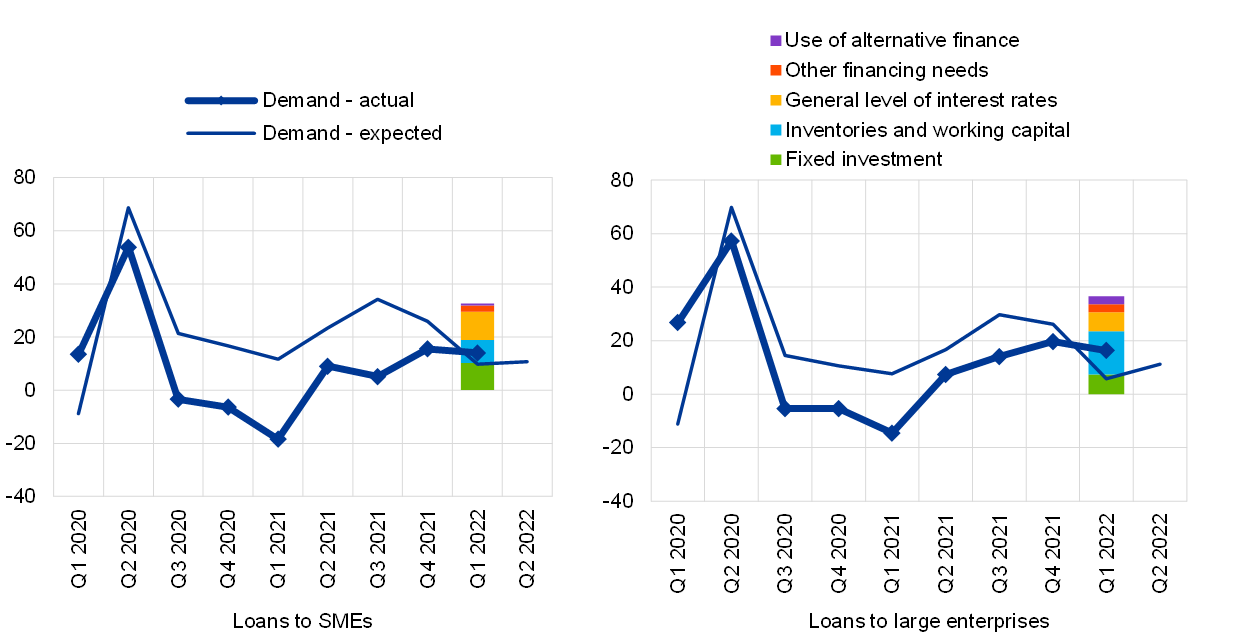
Notes: See notes on Chart 5. Developments across firm sizes in the factors having an impact on loan demand were added in the April 2022 survey round.
Loan demand was mainly driven by higher financing needs of firms for inventories and working capital, whereas the still positive contribution of fixed investment to loan demand moderated following its significant positive contribution in the previous quarter (see Chart 5 and Table 4). The higher financing needs for inventories and working capital reflect supply chain disruptions and higher input costs, especially due to the surge in energy prices and may also reflect precautionary inventories and liquidity holdings. In addition, banks reported a positive impact of the low general level of interest rates, which was higher than in the previous quarter, suggesting higher loan demand from firms to secure currently low financing costs for longer, against the background of expectations of less accommodative monetary policy. Loan demand was also supported, on balance, by other financing needs, which include mergers and acquisitions activity and debt refinancing and restructuring, and by the use of alternative sources of financing, like loans from other banks or non-banks and market-based debt financing. Across firm sizes, banks reported that large firms in particular increased their loan demand for inventories and working capital in the first quarter of 2022, which may suggest that they are more exposed to supply chain disruptions than SMEs (see Chart 6). In addition, alternative external financing sources, lower debt securities issuance in particular, have supported bank loan demand from large firms, according to the reporting banks, while this was, on balance, not the case for SMEs. By contrast, loan demand from SMEs appears to have been driven more strongly by the current low level of interest rates and fixed investment.
Table 4
Factors contributing to changes in demand for loans or credit lines to enterprises
(net percentages of banks)

Note: See the notes on Chart 5.
In the largest euro area countries, banks reported a net increase in demand for loans to firms in Germany and France, while loan demand remained unchanged according to banks in Spain and decreased in Italy in the first quarter of 2022. Financing needs for fixed investment and for working capital as well as the low general level of interest rates had a considerable positive impact on loan demand in Germany and France. In addition, in France, mergers and acquisitions, debt refinancing and restructuring as well as alternative sources of external financing supported loan demand from firms. By contrast, lower loan demand from firms in Italy was driven by a dampening impact of debt refinancing and restructuring, mergers and acquisitions and the general level of interest rates. For firms in Spain, banks indicated fixed investment and mergers and acquisitions as supporting loan demand, whereas firms’ internal funds dampened their loan demand in the first quarter of 2022.
In the second quarter of 2022, euro area banks expect a continued net increase in demand for loans to firms (net percentage of banks at 12%), for both SMEs and large firms (net percentage of 11% for both firm sizes). Demand for short-term loans is expected to increase significantly (net percentage of 21%), signalling expectations of higher financing needs due to increased input costs and possibly lasting supply chain disruptions. By contrast, banks expect demand for long-term loans to decrease slightly in net terms (net percentage of -2%), in line with expectations of a dampening impact of the war and the related heightened uncertainty on firms’ fixed investment.
2.2 Loans to households for house purchase
2.2.1 Credit standards for loans to households for house purchase tightened slightly
In the first quarter of 2022, euro area banks reported a slight net tightening of credit standards for loans to households for house purchase (net percentage of banks at 2%, after 0% in the fourth quarter of 2021; see Chart 7 and Overview table), broadly in line with expectations reported in the previous survey round, and below the historical average for credit standards (6%).
Chart 7
Changes in credit standards applied to the approval of loans to households for house purchase, and contributing factors
(net percentages of banks reporting a tightening of credit standards, and contributing factors)
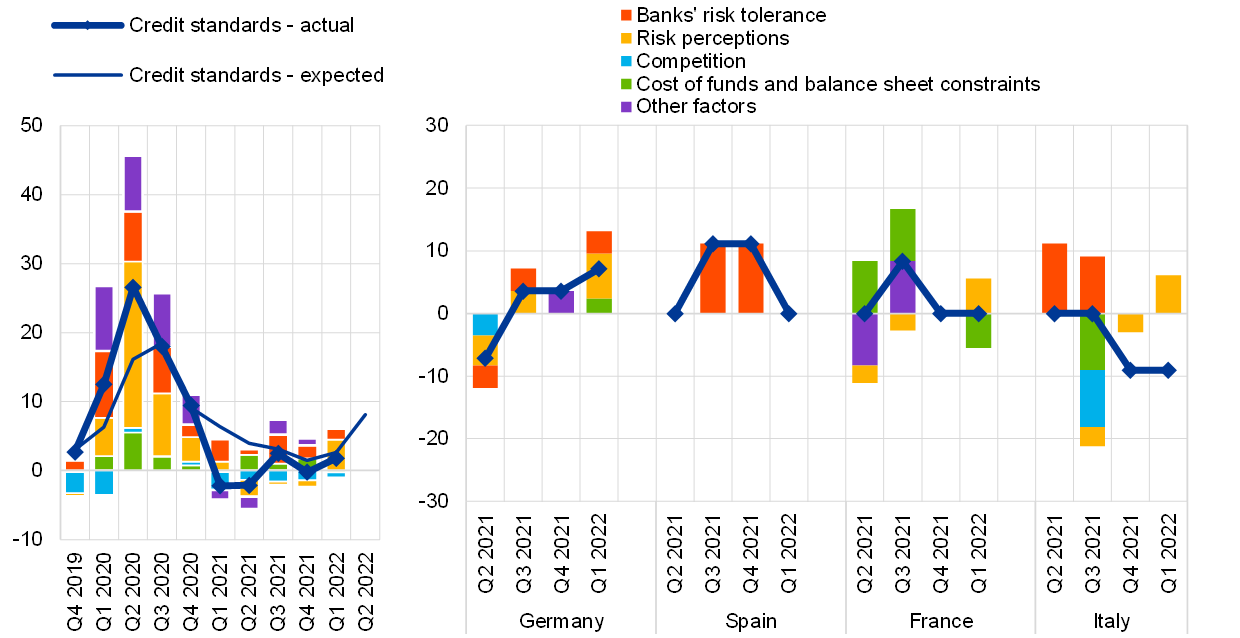
Notes: See the notes on Chart 1. “Cost of funds and balance sheet constraints” is the unweighted average of “bank’s capital and the costs related to bank’s capital position”, “access to market financing” and “liquidity position”; “Risk perceptions” is the unweighted average of “general economic situation and outlook”, “housing market prospects, including expected house price developments” and “borrower’s creditworthiness”; “competition” is the unweighted average of “competition from other banks” and “competition from non-banks”. The net percentages for “other factors” refer to further factors which were mentioned by banks as having contributed to changes in credit standards, currently mainly related to macroprudential policy recommendations.
Perceptions of increased risk and – to a lesser extent – lower risk tolerance contributed to the net tightening of credit standards (see Chart 7 and Table 5). Banks reported an increase in perceived risks for the first time since the fourth quarter of 2020, stemming from housing market prospects, the general economic outlook and borrower creditworthiness. With the exception of the pandemic period, this is the first net tightening impact of risk perceptions since 2014. It likely reflects the increased uncertainty and the economic impact related to the war in Ukraine. It also reflects general concerns about housing markets and borrower creditworthiness as house prices continue to increase, housing lending volumes remain dynamic and bank lending rates for housing loans have started increasing. At the same time, competition from banks and non-banks, and banks’ cost of funds and balance sheet constraints had a broadly neutral impact on credit standards for housing loans.
Across the largest euro area countries, credit standards tightened in net terms in Germany, eased in Italy and remained unchanged in Spain and France. Banks in Germany and Italy reported a net tightening contribution of risk perceptions related to the general economic outlook as well as housing market prospects, while banks in Germany and France reported higher risk perceptions regarding individual borrowers’ creditworthiness. In addition, German banks reported a net tightening impact from their lower risk tolerance as well as from the cost of funds and balance sheet constraints related to higher capital costs and less favourable access to market funding. At the same time, banks in France reported a net easing impact of cost of funds and balance sheet constraints driven by the contribution of their liquidity position.
In the second quarter of 2022, euro area banks expect a moderate, but more pronounced, net tightening of credit standards on loans to households for house purchase (net percentage of banks of 8%).
Table 5
Factors contributing to changes in credit standards for loans to households for house purchase
(net percentages of banks)

Note: See the notes on Chart 7.
2.2.2 Terms and conditions on loans to households for house purchase tightened moderately
Banks reported a moderate net tightening of overall terms and conditions for housing loans in the first quarter of 2022 (net percentage of banks of 6%, after -1% in the previous quarter; see Chart 8 and Table 6). This mainly reflects a slight net tightening of loan-to-value ratios (part of other terms and conditions in Chart 8 and Table 6). At the same time, margins on average loans eased in net terms, while margins on riskier loans remained broadly unchanged. These results imply that the recently observed increases in interest rates for housing loans are more pronounced for riskier borrowers, while banks have not yet fully passed through increased funding costs to average loans, leading to lower margins for these loans.
Chart 8
Changes in terms and conditions on loans to households for house purchase
(net percentages of banks reporting a tightening of terms and conditions)
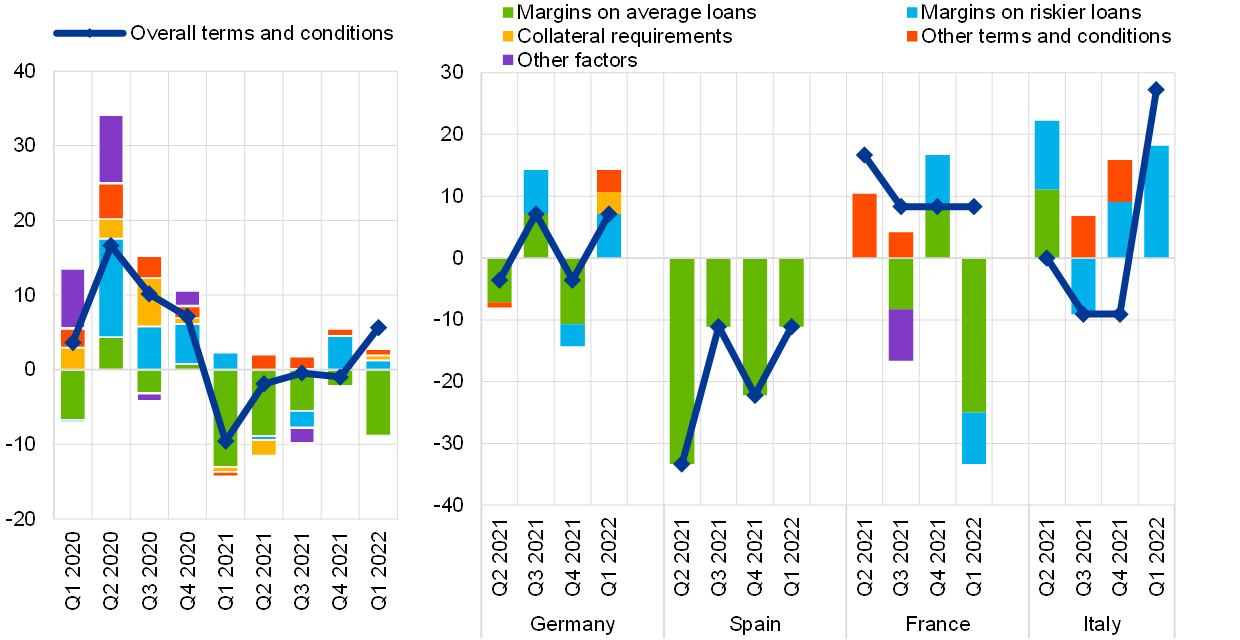
Notes: “Margins” are defined as the spread over a relevant market reference rate. “Other terms and conditions” is the unweighted average of “loan-to-value ratio”, “other loan size limits”, “non-interest rate charges” and “maturity”. The net percentages for “other factors” refer to further factors which were mentioned by banks as having contributed to changes in terms and conditions.
Table 6
Changes in terms and conditions on loans to households for house purchase
(net percentages of banks)

Note: See the notes on Chart 8.
In line with this, banks’ cost of funds and balance sheet constraints contributed to a net tightening of overall terms and conditions and margins, while pressure from competition had a net easing impact (see Table 7). Furthermore, a deterioration in banks’ risk perceptions and lower risk tolerance contributed to tighter overall terms and conditions, while not affecting margins – with the exception of a slight widening impact of risk perceptions on riskier loan margins.
In the largest euro area countries, overall terms and conditions for housing loans tightened in net terms in Germany, France and Italy, and eased in Spain. Wider margins on riskier loans contributed to the tightening in Germany and Italy, while German banks also reported tighter collateral requirements, loan-to-value ratios and other loan size limits, likely reflecting the macroprudential recommendations targeting residential real estate markets in Germany.[6] Both in Germany and Italy, increased risk perceptions and lower risk tolerance contributed to the tightening, while in Italy funding costs also contributed considerably to the tightening. At the same time, margins on average loans narrowed in Spain and France, and in France margins on riskier loans also narrowed, mainly on account of competitive pressures.[7]
Table 7
Factors contributing to changes in overall terms and conditions on loans to households for house purchase
(net percentages of banks)

Note: The net percentages for these questions relating to contributing factors are defined as the difference between the percentage of banks reporting that the given factor contributed to a tightening and the percentage reporting that it contributed to an easing.
2.2.3 Rejection rate for housing loans remained broadly unchanged
In the first quarter of 2022, euro area banks reported, on balance, a broadly unchanged share of rejected formal and informal applications for housing loans (1%, after 2% in the previous quarter).
Across the largest euro area countries, the rejection rate for housing loans remained unchanged in Germany, Spain, France and Italy.
2.2.4 Net demand for housing loans continued to increase
Banks reported a continued increase in net demand for housing loans in the first quarter of 2022 (net percentage of banks of 10%, after 8% in the fourth quarter of 2021; see Chart 9 and Overview table), in line with the dynamic housing loan flows in the first two months of 2022.
Chart 9
Changes in demand for loans to households for house purchase, and contributing factors
(net percentages of banks reporting an increase in demand, and contributing factors)
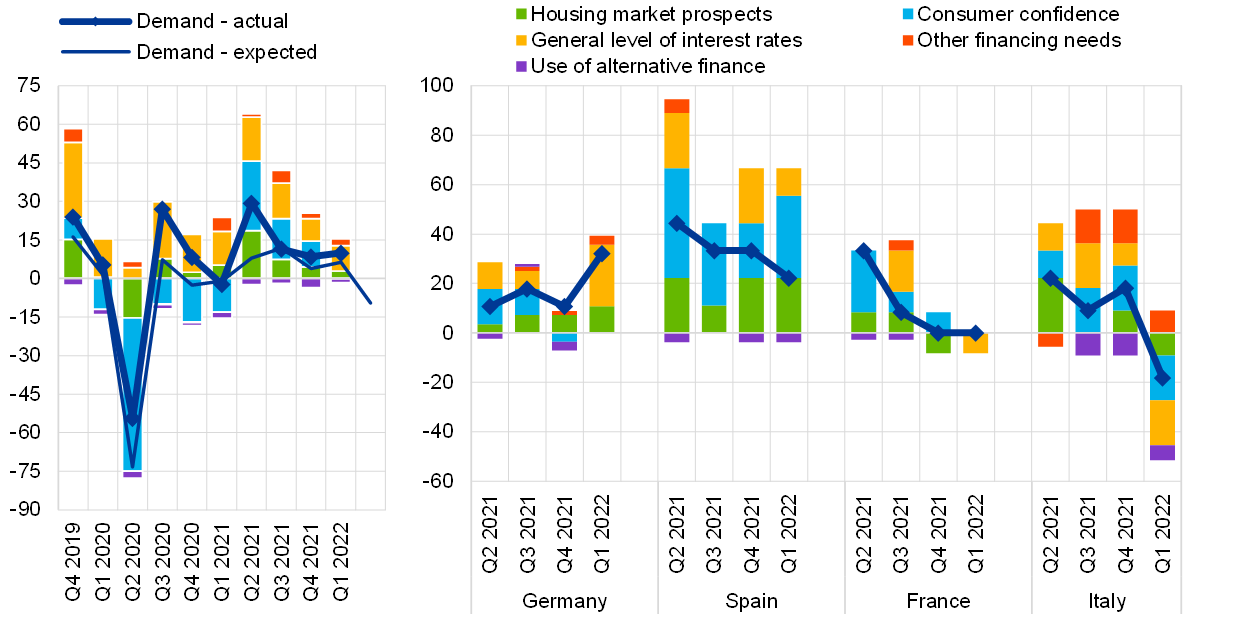
Notes: See the notes on Chart 5. “Other financing needs” is the unweighted average of “debt refinancing/restructuring and renegotiation” and “regulatory and fiscal regime of housing markets”; “use of alternative finance” is the unweighted average of “internal finance of house purchase out of savings/down payment”, “loans from other banks” and “other sources of external finance”.
The low general level of interest rates and – to a lesser extent – housing market prospects contributed, in net terms, to an increase in housing loan demand (see Chart 9 and Table 8). The positive net impact of the level of interest rates on loan demand, despite rates on housing loans starting to increase since the beginning of 2022, may reflect anticipation effects of further increases in interest rates as bank funding costs rise. This interpretation is supported by the fact that this factor is particularly relevant in Germany where rates had already increased for five consecutive months up to February 2022. The positive net contribution of housing market prospects to loan demand decreased further compared with previous quarters, pointing to potential vulnerabilities, in line with the tightening contribution of this factor to credit standards. In addition, other financing needs contributed moderately to a net increase in demand, while consumer confidence and the use of alternative finance had a broadly neutral impact.
Across the largest euro area countries, banks in Germany and Spain reported a net increase in housing loan demand in the first quarter of 2022, whereas banks in France reported unchanged demand for housing loans, and Italian banks reported a net decrease. In Germany, the low level of interest rates was the most important factor contributing to the net increase in demand, which may indicate that borrowers aim to secure the currently still low lending rates for longer-term real estate borrowing. In addition, housing market prospects and other financing needs supported loan demand in Germany. In Spain, consumer confidence and housing market prospects mainly contributed positively to housing loan demand, while households’ use of loans from other banks contributed to a net decline. By contrast, the current level of interest rates contributed to a net decline in housing loan demand in France and Italy. In addition, in Italy, lower consumer confidence, lower housing market prospects and the use of alternative financing had a negative impact on demand.
In the second quarter of 2022, banks expect a net decline in the demand for housing loans (net percentage of banks of -10%).
Table 8
Factors contributing to changes in demand for loans to households for house purchase
(net percentages of banks)

Note: See the notes on Chart 9.
2.3 Consumer credit and other lending to households
2.3.1 Credit standards for consumer credit and other lending to households eased moderately
Banks reported a moderate net easing for credit standards on consumer credit and other lending to households in the first quarter of 2022 (net percentage of -5%; see Chart 10 and Overview table), following a similarly moderate net easing (-4%) of credit standards in the previous BLS round.
Increased risk tolerance on the part of banks mainly contributed to the net easing in credit standards (see Chart 10 and Table 9). Risk perceptions relating to the broad economic outlook had a marginal contribution towards a net easing, while all other factors had broadly neutral effects.
Across the largest euro area countries, credit standards for consumer credit and other lending to households eased in Italy and France, owing to increased risk tolerance. In addition, lower risk perceptions relating to the general economic outlook and the risk on the collateral demanded had an easing impact for banks in France. Banks in Germany and Spain reported unchanged credit standards.
In the second quarter of 2022, euro area banks expect a moderate net tightening of credit standards for consumer credit and other lending to households (net percentage of 7%).
Chart 10
Changes in credit standards applied to the approval of consumer credit and other lending to households, and contributing factors
(net percentages of banks reporting a tightening of credit standards, and contributing factors)
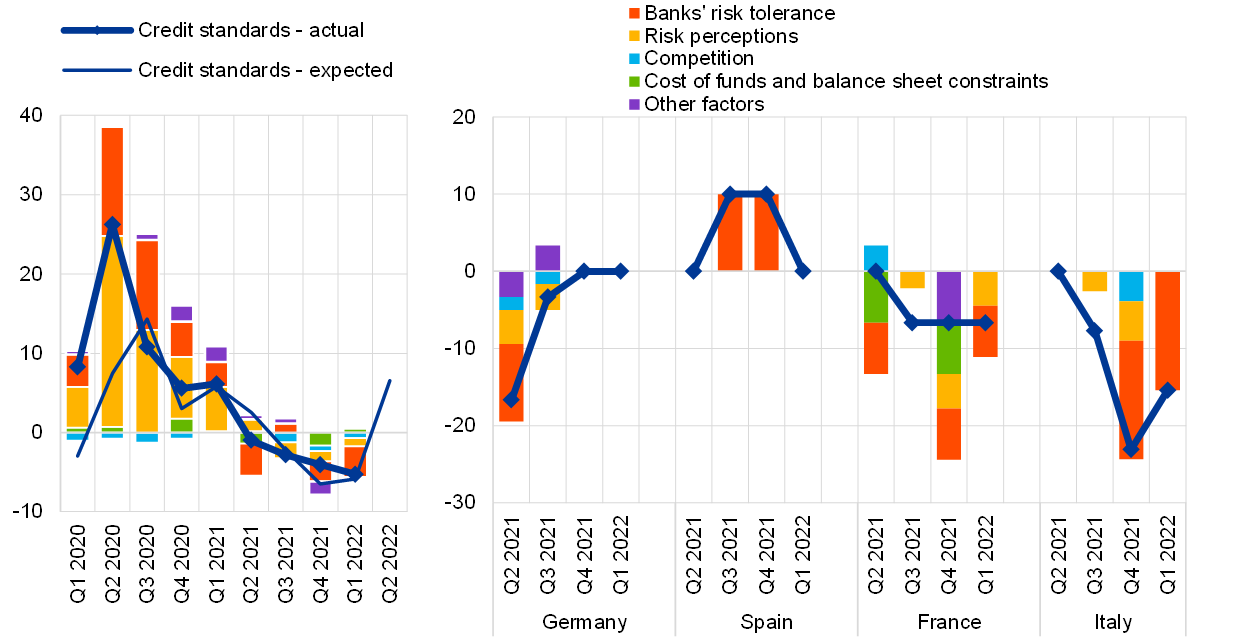
Notes: See the notes on Chart 1. “Cost of funds and balance sheet constraints” is the unweighted average of “bank’s capital and the costs related to bank’s capital position”, “access to market financing” and “liquidity position”; “Risk perceptions” is the unweighted average of “general economic situation and outlook”, “creditworthiness of consumers” and “risk on the collateral demanded”; “competition” is the unweighted average of “competition from other banks” and “competition from non-banks”. The net percentages for “other factors” refer to further factors which were mentioned by banks as having contributed to changes in credit standards.
Table 9
Factors contributing to changes in credit standards for consumer credit and other lending to households
(net percentages of banks)

Note: See the notes on Chart 10.
2.3.2 Terms and conditions on consumer credit and other lending to households eased slightly
In the first quarter of 2022, banks’ overall terms and conditions applied when granting consumer credit and other lending to households eased slightly (net percentage of -2%, after -1% in the previous quarter; see Chart 11 and Table 10). This was because of a considerable narrowing of margins for average loans (net percentage of -12%) and a more moderate narrowing for riskier loans (-4%).
Chart 11
Changes in terms and conditions on consumer credit and other lending to households
(net percentages of banks reporting a tightening of terms and conditions)

Notes: “Margins” are defined as the spread over a relevant market reference rate. “Other terms and conditions” is the unweighted average of “size of the loan”, “non-interest rate charges” and “maturity”. The net percentages for “other factors” refer to further factors which were mentioned by banks as having contributed to changes in terms and conditions.
Pressure from competition continued to have a moderate net easing impact (see Table 11). In line with developments in credit standards, increased risk tolerance also had a slight easing impact. By contrast, banks’ costs of funds and balance sheet constraints had a small tightening effect on terms and conditions, likely reflecting the tightening of banks’ market-based funding conditions. Risk perceptions had a broadly neutral impact.
Across the largest euro area countries, overall terms and conditions on consumer credit and other lending to households eased in net terms in France, tightened in Italy, and remained broadly unchanged in Spain and Germany. A narrowing of margins on both average and riskier loans contributed to the easing in France, and was driven by pressure from competition, improved risk perceptions and increased risk tolerance. By contrast, French banks reported that their cost of funds and balance sheet constraints had a net tightening effect. The reported tightening of terms and conditions in Italy is the result of increases in non-interest charges. By contrast, Italian banks reported a narrowing of margins on average loans, but margins on riskier loans were unchanged. In Germany, while overall terms and conditions were unchanged, margins on both average and riskier loans narrowed moderately, reflecting a net easing contribution of banks’ funding costs.
Table 10
Changes in terms and conditions on consumer credit and other lending to households
(net percentages of banks)

Note: See the notes on Chart 11.
Table 11
Factors contributing to changes in overall terms and conditions on consumer credit and other lending to households
(net percentages of banks)

Note: The net percentages for these questions relating to contributing factors are defined as the difference between the percentage of banks reporting that the given factor contributed to a tightening and the percentage reporting that it contributed to an easing.
2.3.3 Rejection rate for consumer credit and other lending to households decreased slightly
In the first quarter of 2022, euro area banks reported a slight net decrease in the share of rejected formal and informal applications for consumer credit and other lending to households (-2%, after -3% in the previous survey round). This is consistent with the reported net easing in credit standards for consumer credit and other lending to households in the first quarter of 2022.
Across the largest euro area countries, the rejection rate decreased on balance in Germany, Italy and France, whereas it increased in Spain.
2.3.4 Net demand for consumer credit and other lending to households increased
In the first quarter of 2022, banks reported a net increase in demand for consumer credit and other lending to households (net percentage of banks at 11%, after 2% in the previous quarter; see Chart 12 and Overview table), which was higher than in the previous quarter. This is broadly in line with recently observed increases in the annual growth rate of credit for consumption.
Chart 12
Changes in demand for consumer credit and other lending to households, and contributing factors
(net percentages of banks reporting an increase in demand, and contributing factors)

Notes: See the notes on Chart 5. “Use of alternative finance” is the unweighted average of “internal financing out of savings”, “loans from other banks” and “other sources of external finance”. “Consumption exp. (real estate)” denotes “consumption expenditure financed through real estate-guaranteed loans”.
Spending on durable goods made the largest positive contribution to demand for consumer credit, in contrast with a slight negative effect in the previous quarter (see Chart 12 and Table 12). In addition, consumer confidence continued to have a moderate positive impact in the first quarter of 2022, despite the decline in the European Commission’s consumer confidence indicator in March 2022. The general level of interest rates, use of alternative finance or alternative bank loans and mortgage equity withdrawal all had no strong effect on demand for consumer credit in the first quarter of 2022.
Across all four largest euro area countries, banks reported a net increase in demand for consumer credit. Higher spending on durables partially explained the net increase in demand in all countries, while in Germany, Spain and France higher consumer confidence also contributed to the net increase in demand. On the other hand, French banks reported that the general level of interest rates contributed negatively to demand for consumer credit, and Italian banks stated that internal financing out of savings had a dampening impact. In Germany, loans from other banks had a slight negative contribution to net demand.
In the second quarter of 2022, banks expect demand for consumer credit and other lending to remain broadly unchanged (net percentage of 1%).
Table 12
Factors contributing to changes in demand for consumer credit and other lending to households
(net percentages of banks)

Note: See the notes on Chart 12.
3 Ad hoc questions
3.1 Banks’ access to retail and wholesale funding
The April 2022 survey included a question asking banks to assess the extent to which the situation in the financial markets has affected their access to retail and wholesale funding.
In the first quarter of 2022, banks reported that their access to money markets, securitisation and particularly debt securities deteriorated, in net terms, reflecting the tightening of market-based funding conditions for banks. By contrast, access to retail funding remained broadly unchanged (net percentage of -1% reported deteriorated access, after -5% in 2021 Q4, see Chart 13 and Table 13). In detail, access to short-term deposit funding continued to improve, whereas access to long-term deposits remained broadly unchanged in the first quarter of 2022. This is consistent with actual developments in deposits held by firms and households. Household deposit inflows remained robust in the first two months of 2022, and deposit flows of firms, which declined at the start of the year, increased strongly again in February 2022, likely reflecting a re-emergence of precautionary liquidity holdings due to supply chain disruptions and high uncertainty because of the war in Ukraine.
Chart 13
Banks’ assessment of funding conditions and the ability to transfer credit risk off the balance sheet
(net percentages of banks reporting a deterioration in market access)
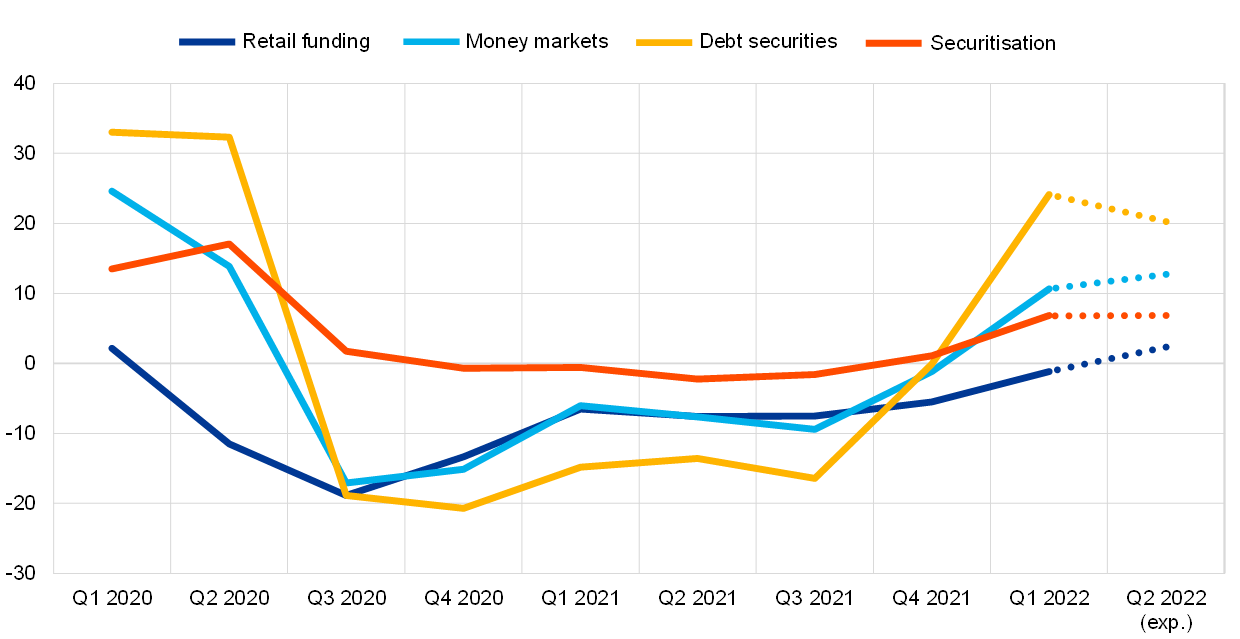
Note: The net percentages are defined as the difference between the sum of the percentages of banks responding “deteriorated considerably” and “deteriorated somewhat” and the sum of the percentages of banks responding “eased somewhat” and “eased considerably”.
Table 13
Banks’ assessment of funding conditions and the ability to transfer credit risk off the balance sheet
(net percentages of banks reporting a deterioration in market access)

Note: See the notes on Chart 13.
In the second quarter of 2022, euro area banks expect, on balance, a continued deterioration in their access to money markets, debt securities and securitisation, which may partly reflect the anticipation of less accommodative monetary policy. In addition, they expect a slight deterioration in their access to retail funding.
3.2 The impact of the ECB’s asset purchase programmes
The April 2022 survey questionnaire included two biannual ad hoc questions gauging the impact of the ECB’s asset purchase programmes. When answering the questions on the impact of those programmes over the past and next six months, banks were asked to take into account the impact of the ECB’s net asset purchases and the reinvestment of the principal payments from maturing securities purchased. Banks were also asked to consider both the direct and indirect effects of the ECB’s asset purchase programmes.
3.2.1 Impact of the ECB’s asset purchase programmes on banks’ financial situation
Euro area banks reported, in net terms, that the ECB’s asset purchase programmes continued to have a positive impact on their liquidity position and their market financing conditions, but led to a deterioration in their profitability over the past six months (see Charts 14 and 15). Compared with their indications in the October 2021 BLS, banks reported, in net terms, a smaller positive impact of the ECB’s asset purchases for the period from the fourth quarter of 2021 to the first quarter of 2022 on their liquidity position (net percentage of 8%, after 26%) and market financing conditions (net percentage of 13%, after 28%). In addition, they indicated a continued positive impact on their total assets (net percentage of 6%, after 9%), in line with the reported positive impact on lending volumes (see below). At the same time, banks continued to indicate a negative impact of the ECB’s asset purchase programmes on their profitability (net percentage of ‑7%, after -11%), mainly owing to the negative impact on their net interest income (net percentage of ‑11%, after ‑21%).
Chart 14
Overview of the impact of the ECB’s asset purchase programmes on euro area banks’ financial situation
(net percentages of banks reporting an increase/improvement)

Notes: The net percentages are defined as the difference between the sum of the percentages for “increased/improved considerably” and “increased/improved somewhat” and the sum of the percentages for “decreased/deteriorated somewhat” and “decreased/deteriorated considerably”. The last period denotes expectations indicated by banks in the current round.
Chart 15
Impact of the ECB’s asset purchase programmes on bank profitability
(net percentages of banks reporting an increase/improvement)
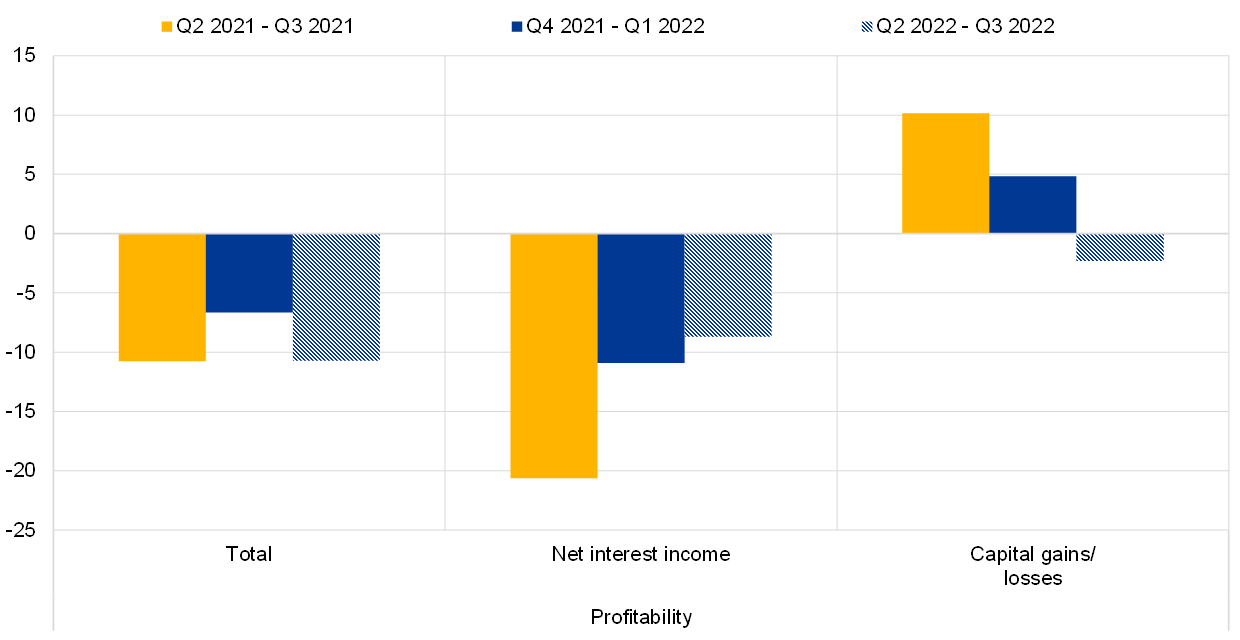
Notes: See the notes on Chart 14. The last period denotes expectations indicated by banks in the current round.
Over the next six months, euro area banks expect, on balance, that the positive impact of the ECB’s asset purchase programmes on their liquidity position and market financing conditions will turn into a negative impact (net percentages of banks of -6% and -12%, respectively). The expected deterioration is likely related to the envisaged scaling down of monetary policy accommodation, specifically the end of the ECB’s net asset purchases under the PEPP in March 2022 and the reduction in the monthly net asset purchases under the APP over the next six months. In addition, banks expect a continued negative impact of the ECB’s asset purchases on their profitability (net percentage of -11%), driven by the negative impact on net interest income, but also due to expected capital losses.
3.2.2 Impact of the ECB’s asset purchase programmes on banks’ lending conditions and lending volumes
Over the past six months, euro area banks reported a net easing impact of the ECB’s asset purchase programmes on their terms and conditions for loans to enterprises and housing loans (net percentages of banks of -7% and -3%, respectively), while the impact was neutral for consumer credit (0%; see Chart 16). Regarding credit standards, banks reported a moderate net easing impact for loans to firms (net percentage of -4%). By contrast, the impact on credit standards was neutral for loans to households over the past six months.
Chart 16
Impact of the ECB’s asset purchase programmes on bank lending
(net percentages of banks reporting a tightening)
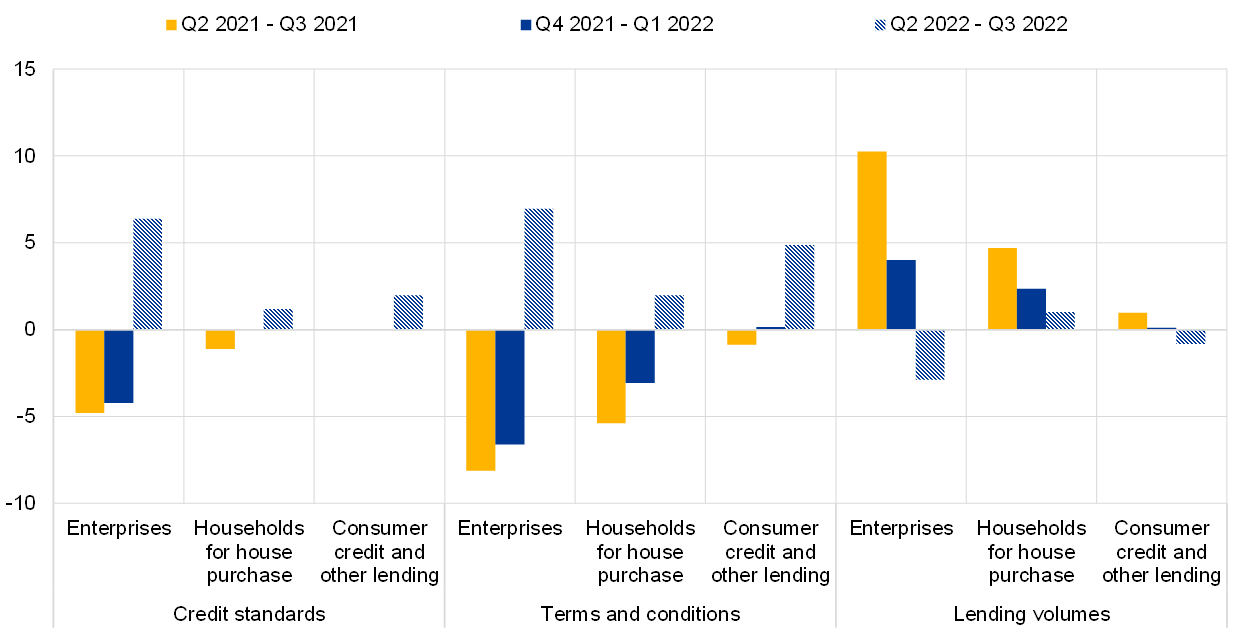
Notes: The net percentages are defined as the difference between the sum of the percentages for “tightened/increased considerably” and “tightened/increased somewhat” and the sum of the percentages for “eased/decreased somewhat” and “eased/decreased considerably”. The last period denotes expectations indicated by banks in the current round.
On lending volumes, euro area banks reported, in net terms, a continued, albeit smaller, positive impact of the ECB’s net asset purchases for loans to firms and households for house purchase over the past six months (see Chart 16). The impact was more pronounced for loans to firms (net percentage of 4%, after 10%) than for housing loans (net percentage of 2%, after 5%) and neutral for consumer credit for the period from the fourth quarter of 2021 to the first quarter of 2022.
Over the next six months, banks expect, in net terms, a limited tightening impact of the envisaged reduction in the ECB’s monthly net asset purchases on their terms and conditions for loans to enterprises (net percentage of 7%), housing loans and consumer credit (net percentages of 2% and 5%, respectively). They also expect a net tightening impact of the scaling down of the ECB’s net asset purchases on their credit standards over the next six months, mainly for loans to enterprises (net percentage of 6%), while the impact is expected to be small or neutral for loans to households (net percentage of 1% for housing loans and 2% for consumer credit). The expected net tightening is in line with the expected negative effect of the reduction in the ECB’s net asset purchases on banks’ market financing conditions and liquidity position (see above), which can be expected to be passed on to borrowers.
Euro area banks expect a limited dampening impact of the scaling down of the ECB’s monthly net asset purchases on their lending volumes for loans to enterprises (net percentage of -3%), and a broadly neutral impact for loans to households (net percentages of 1% for housing loans and -1% for consumer credit) over the next six months.
3.3 The impact of the ECB’s negative deposit facility rate and the ECB’s two-tier system
The April 2022 survey questionnaire included a biannual ad hoc question aimed at gauging the direct and indirect effects of the ECB’s negative deposit facility rate (DFR) and the ECB’s two-tier system. In the first part of the question, banks were asked to indicate the overall impact of the DFR, including the impact of the ECB’s two-tier system. In the second part of the question, banks were asked to single out the impact of the ECB’s two-tier system compared with the situation in which no two-tier system would exist.
3.3.1 Impact of the ECB’s negative deposit facility rate
Euro area banks reported, in net terms, a negative impact of the ECB’s negative DFR (including the impact of the ECB’s two-tier system) on bank profitability over the past six months (net percentage of banks of -48%, after -52%; see Chart 17). This was again driven by a negative net impact on banks’ net interest income[8] (net percentage of -47%, after -49%), which is in line with the still low loan-to-deposit margin observed between October 2021 and February 2022. Over the next six months, euro area banks expect a similar negative impact on their profitability and net interest income, as was the case in the past six months.
The negative DFR continued to depress lending rates, in net terms, across all loan categories (see Chart 18). The impact was less pronounced than reported in the previous round for loans to firms (-14%, after -26%), housing loans (-14%, after ‑25%) and for consumer credit and other lending (-9%, after -12%). For the next six months, banks expect a continued negative, albeit somewhat smaller net impact on lending rates.
Chart 17
Impact of the negative DFR on bank profitability
(net percentages of banks reporting an increase)
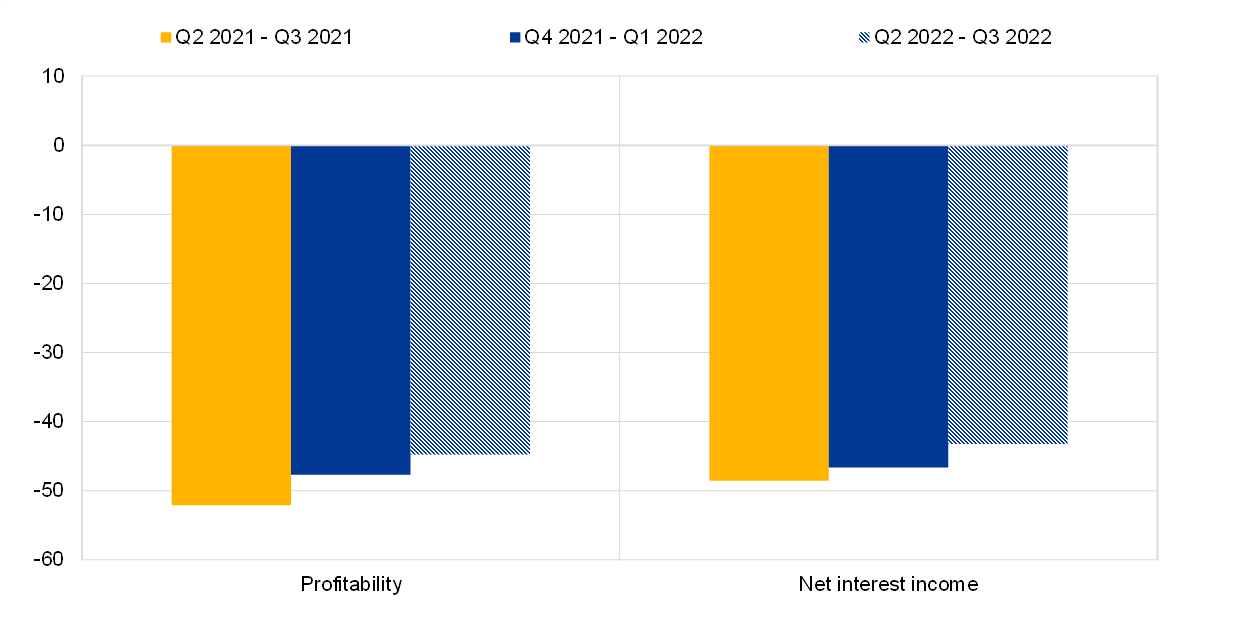
Notes: Includes the impact of the ECB’s two-tier system for remunerating excess liquidity holdings. The net percentages are defined as the difference between the sum of the percentages for “increased considerably” and “increased somewhat” and the sum of the percentages for “decreased somewhat” and “decreased considerably”. The last period denotes expectations indicated by banks in the current round.
Chart 18
Impact of the negative DFR on bank lending
(net percentages of banks reporting an increase)
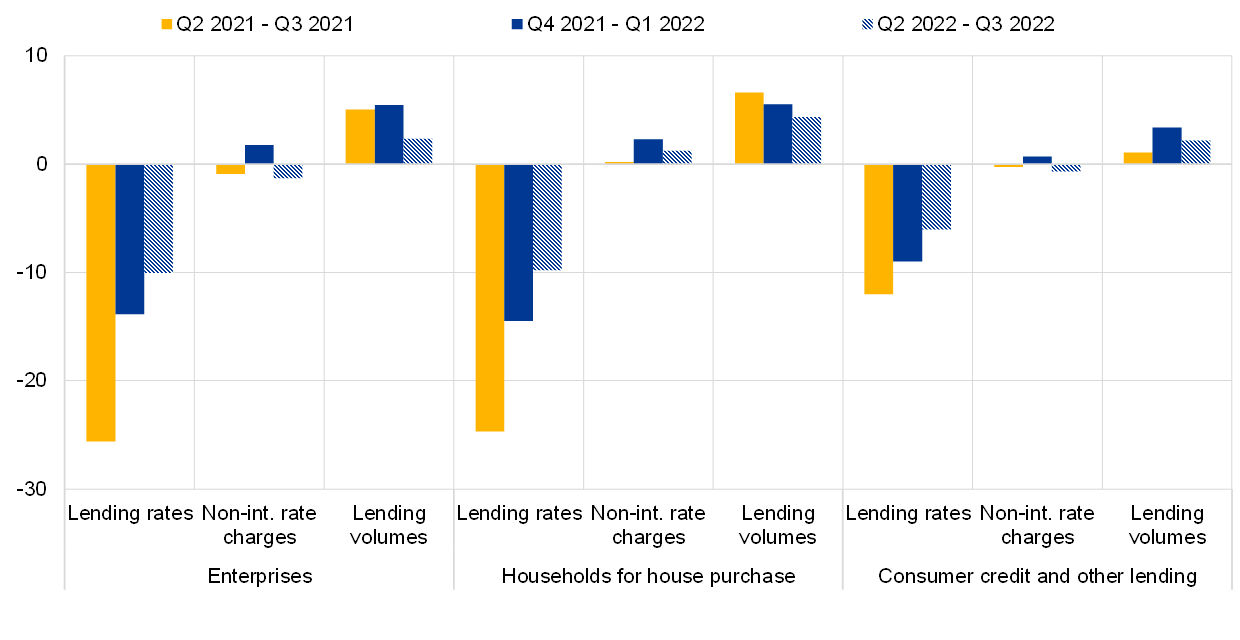
Notes: Includes the impact of the ECB’s two-tier system for remunerating excess liquidity holdings. The net percentages are defined as the difference between the sum of the percentages for “increased considerably” and “increased somewhat” and the sum of the percentages for “decreased somewhat” and “decreased considerably”. The last period denotes expectations indicated by banks in the current round.
Euro area banks reported, in net terms, a positive impact of the DFR on lending volumes for loans to enterprises and households (see Chart 18). The positive impact was similar across the three loan categories, i.e. loans to firms (net percentage of 5%, after 5%), housing loans (6%, after 7%) and consumer credit (3%, after 1%). Over the next six months, banks expect a continued positive, albeit smaller net impact on lending volumes to firms and households.
For rates on deposits held by firms and households, euro area banks reported a continued negative net impact of the DFR over the past six months, which remained more pronounced for firms than for households (net percentages of -31% and -19%, respectively; see Chart 19). In addition to the pass-through to deposit rates, banks also continued to report a positive net impact of the negative DFR on non-interest charges for deposits from firms and households (net percentages at 16% and 6%, respectively; see Chart 20). Over the next six months, banks expect, on balance, a continued negative impact of the DFR on deposit rates and a continued net positive impact on non-interest rate charges for firms and households.
Over the past six months, the negative DFR had a moderately positive net impact on deposit volumes, both for firms and households, according to banks (net percentages of 3% for both categories; see Chart 19), which is somewhat smaller than the impacts reported in previous survey rounds. The positive impact of the DFR on deposit inflows implies that the policy continues to support banks’ funding costs as deposit funding remains an important source of funding for banks. Firms and households continue to hold liquidity in the form of deposits given the dearth of attractive financial investment alternatives in the current low interest rate environment but potentially also due to demand for precautionary liquidity buffers. Over the next six months, banks expect a slightly positive net impact of the DFR on deposit volumes from firms and households.
Chart 19
Impact of the negative DFR on bank deposits
(net percentages of banks reporting an increase)
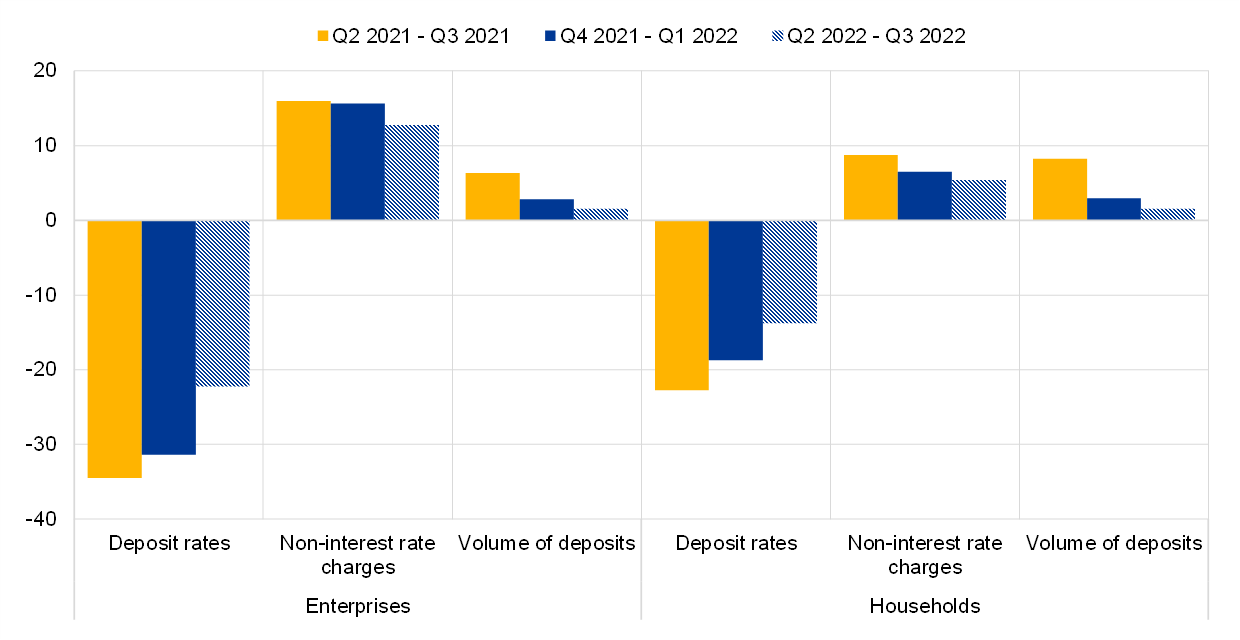
Notes: Includes the impact of the ECB’s two-tier system for remunerating excess liquidity holdings. The net percentages are defined as the difference between the sum of the percentages for “increased considerably” and “increased somewhat” and the sum of the percentages for “decreased somewhat” and “decreased considerably”. The last period denotes expectations indicated by banks in the current round.
3.3.2 Impact of the ECB’s two-tier system for remunerating excess liquidity holdings
Regarding the impact of the ECB’s two-tier system, compared with the situation in which no two-tier system would exist, a large net percentage of euro area banks reported a continued positive impact on their profitability (net percentage of 55%, after 56%; see Chart 20), mainly related to a positive impact on net interest income (55%, after 58%). Compared with the previous survey round, banks reported only a slight positive impact of the two-tier system on their liquidity position (2%, after 6%) and broadly no impact on their market financing conditions (1%, after 3%) over the past six months. Over the next six months, banks expect a similar or somewhat smaller positive impact for their profitability and liquidity position, while they expect a slightly negative net impact of the two-tier system on their market financing conditions.
Euro area banks further reported that, on balance, the two-tier system had broadly no impact on lending rates and deposit rates over the past six months, as compared with a situation with no such system (see Chart 21). For lending rates, the broadly neutral impact is in line with results reported in previous survey rounds. For deposit rates, banks reported no further impact over the past six months after referring to moderate positive impacts in the October 2021 survey round. For the next six months, banks expect a small positive net impact on lending rates for firms and households and deposit rates for households.
Chart 20
Impact of the ECB’s two-tier system on banks’ financial situation
(net percentages of banks reporting an increase/improvement)
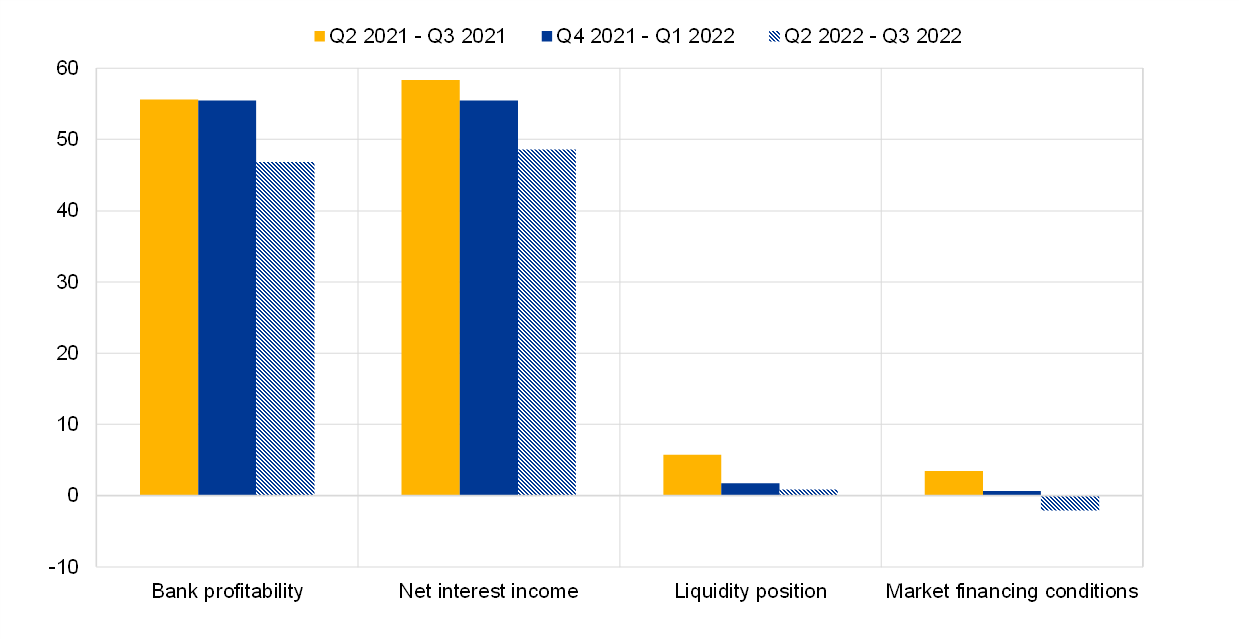
Notes: The net percentages are defined as the difference between the sum of the percentages for “increased/improved considerably” and “increased/improved somewhat” and the sum of the percentages for “decreased/deteriorated somewhat” and “decreased/deteriorated considerably”. The last period denotes expectations indicated by banks in the current round.
Chart 21
Impact of the ECB’s two-tier system on bank lending rates and bank deposit rates
(net percentages of banks reporting an increase)
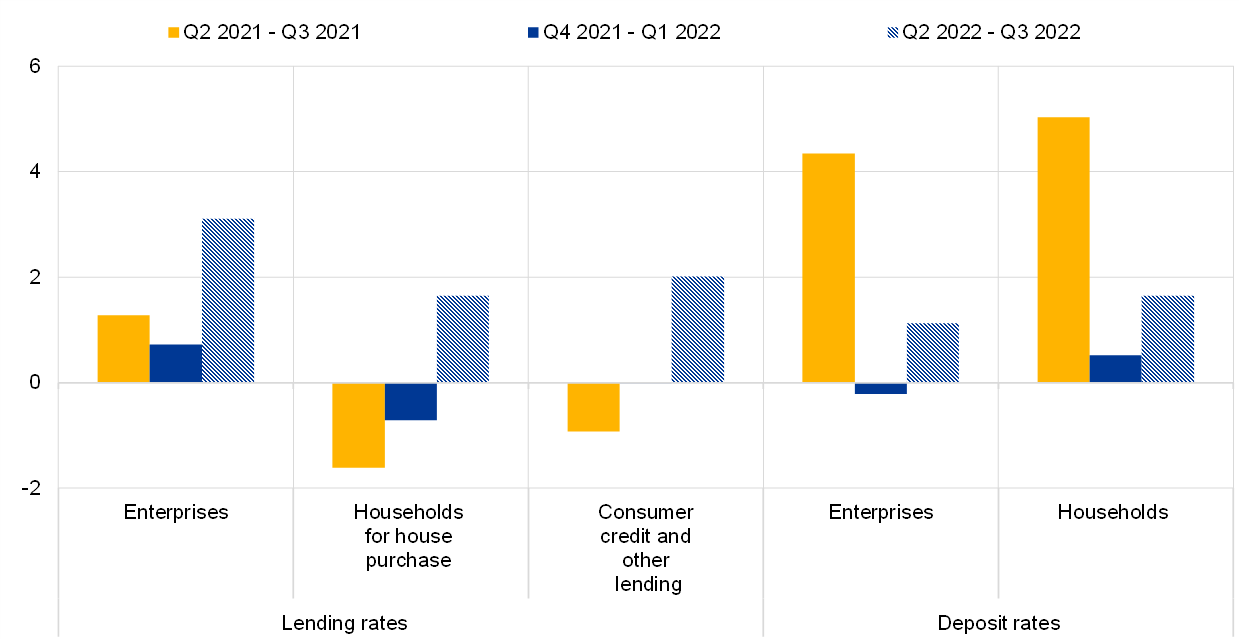
Notes: The net percentages are defined as the difference between the sum of the percentages for “increased considerably” and “increased somewhat” and the sum of the percentages for “decreased somewhat” and “decreased considerably”. The last period denotes expectations indicated by banks in the current round.
3.4 The impact of TLTRO III on banks and their lending policies
The April 2022 survey questionnaire included some ad hoc questions on the impact of the Eurosystem’s third series of targeted longer-term refinancing operations (TLTRO III). Banks were asked about their participation in that series of operations and their reasons for participating, as well as about their use of TLTRO III liquidity. In addition, they were asked about the impact of TLTRO III on their financial situation, as well as on their lending conditions and lending volumes over the past six months and the next six months.
In the last operation of the TLTRO III programme, conducted in December 2021, 18% of the banks surveyed in the BLS participated (see Chart 22). Banks’ participation was similar to the September 2021 operation but lower than in previous TLTRO III allotments. This is in line with the lower overall take-up of TLTRO III funds in the December 2021 operation, which likely reflects banks’ reduced borrowing allowances due to the high take-up in previous operations and the relatively less favourable conditions compared with previous operations when banks were able to obtain the low rates of the additional special interest rate period (ending in June 2022) for a longer period. Given that the last operation of the TLTRO III programme was conducted in December 2021, banks were not asked about future participation in the programme.
Profitability (attractiveness of TLTRO III conditions) remained the most important reason for banks’ participation in TLTRO III (18% of BLS banks for the December 2021 operation, after 15% for the September 2021 operation; see Chart 22)[9], with all participating banks mentioning this reason.[10] The precautionary motive, i.e. the avoidance or reduction of funding difficulties, (7% in December, after 3% in September) and the fulfilment of regulatory or supervisory requirements (6% in December, after 4% in September) were less relevant for banks and reported by around 40% of participating banks.
Chart 22
Banks’ participation in TLTRO III and their reasons for participating
(percentages of banks)
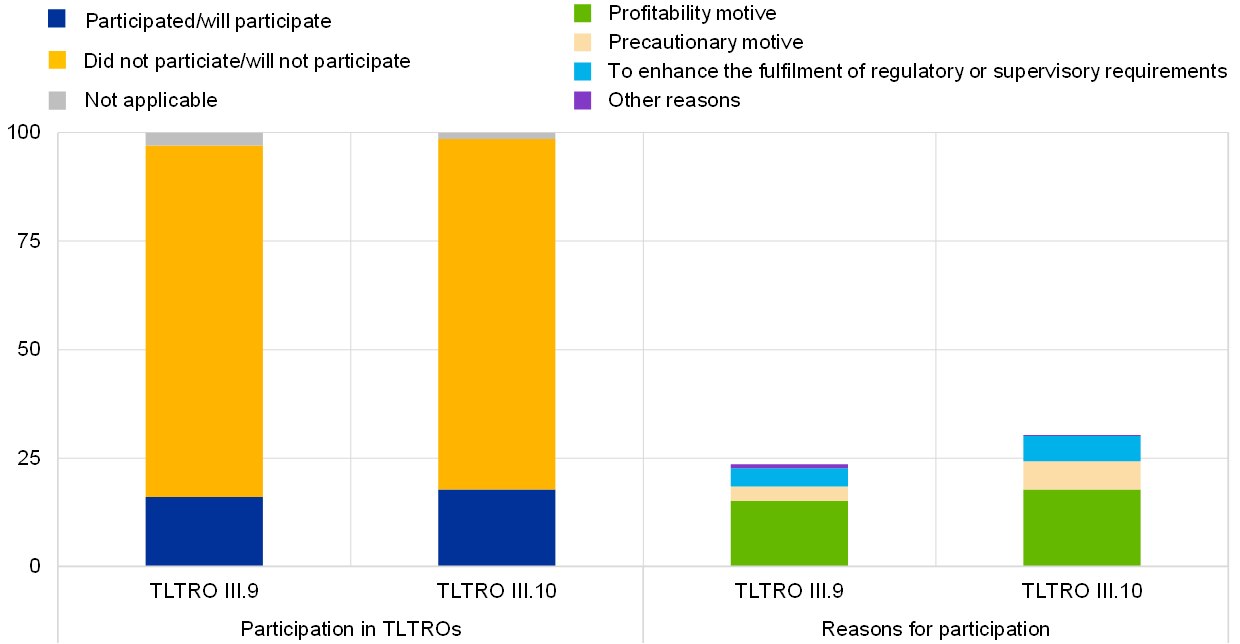
Notes: TLTRO III.9 in September 2021 corresponds to the “next to last TLTRO” in the questionnaire. TLTRO III.10 in December 2021 corresponds to the “most recent TLTRO”. Unweighted percentages of banks at national level for participation. Banks were asked to rate all reasons in terms of the extent to which they have contributed to their participation in TLTRO III. “Other reasons” are specific reasons cited by banks that were not included in the questionnaire.
Granting loans to the non-financial private sector remained the most common use of TLTRO III liquidity over the past six months (56% of BLS banks reported this use of funds, after 46% in the October 2021 round; see Chart 23). In addition, 44% (after 38%) of banks indicated holding TLTRO III liquidity with the Eurosystem as a further use of funds. The use of TLTRO III liquidity by banks for refinancing purposes (percentage of banks at 13%, after 12%) and for purchasing assets was more limited (percentage of banks at 14%, after 12%).
Over the next six months, granting loans remains the most important purpose, reported by 41% of the euro area banks, while 37% referred to holding liquidity with the Eurosystem. Refinancing and the purchase of assets are expected to continue playing a more limited role in the next six months (mentioned by 11% and 10% of the banks, respectively).
Chart 23
Use of TLTRO III liquidity by banks
(percentages of banks)

Notes: Banks were asked to indicate the relevance of all purposes. "Purchasing financial assets" is the average of “purchasing domestic sovereign bonds” and “purchasing other financial assets”. “Granting loans” refers to loans to the non-financial private sector. The last period denotes expectations indicated by banks in the current round.
Banks indicated an overall positive impact of TLTRO III on their financial situation over the past six months, which, however, is expected to become smaller in the coming months (see Chart 24). Banks reported a continued positive impact of TLTRO III mainly via their liquidity position and profitability, implying a sustained positive impact of the large outstanding TLTRO liquidity despite the lower take-up in the December 2021 operation. The positive impact on market financing conditions was also still significant but lower compared with previous survey rounds. Over the next six months, banks expect a continued positive, albeit more limited impact on their financial situation, likely reflecting the expected reduction in TLTRO III liquidity.
Regarding their terms and conditions, banks reported a net easing impact of TLTRO III across all loan categories over the past six months (see Chart 25). The net percentage of banks reporting an easing impact on terms and conditions was larger for loans to enterprises (net percentage of -20%, after -23%) than for housing loans (-7%, after -5%) and consumer credit (-6%, after -9%). Regarding credit standards, TLTRO III had a more moderate net easing impact on loans to firms (net percentage of -10% after -9%) and housing loans (-3%, after -2%), and a similar impact compared with terms and conditions for consumer credit in the current round (-6%, after -1%). Thus, TLTRO III continues to ease lending conditions for firms and households, notwithstanding the decline in the uptake, and in line with the continued positive impact on banks’ financial conditions.
Chart 24
Impact of TLTRO III on banks’ financial situation
(net percentages of banks reporting an improvement)
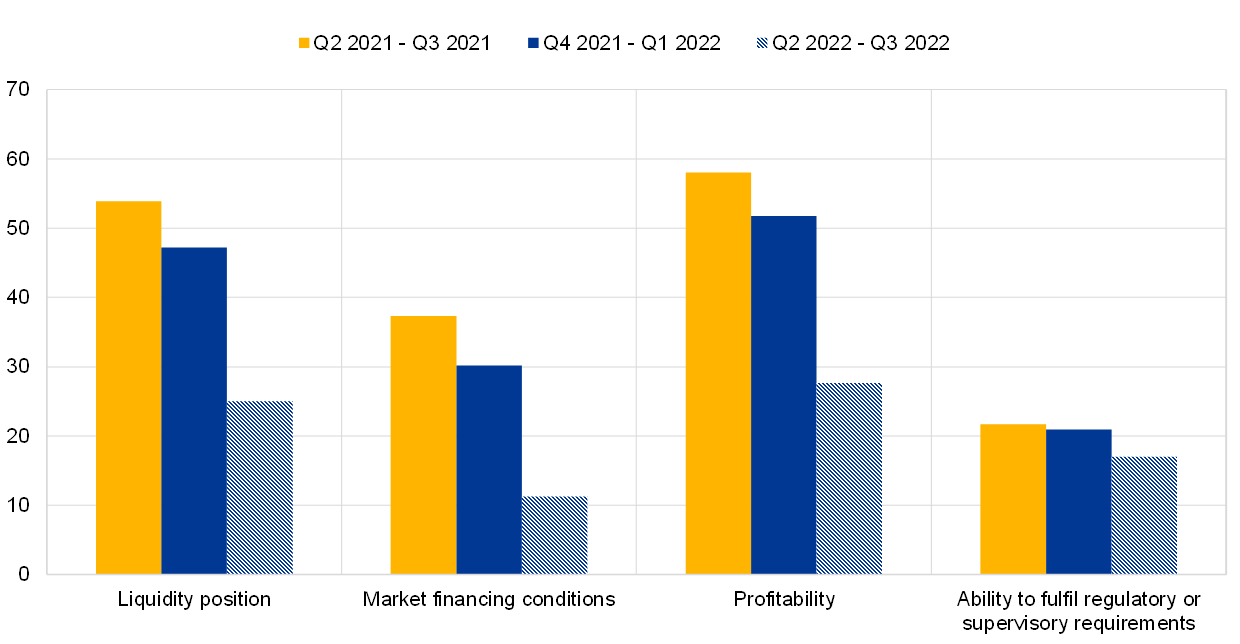
Notes: The signs for these net percentages have been inverted to show net improvements. The net percentages are defined as the difference between the sum of the percentages for “contributed considerably to an improvement” and “contributed somewhat to an improvement” and the sum of the percentages for “contributed somewhat to a deterioration” and “contributed considerably to a deterioration". The last period denotes expectations indicated by banks in the current round.
Chart 25
Impact of TLTRO III on bank lending conditions and lending volumes
(net percentages of banks reporting a tightening /an increasing impact)
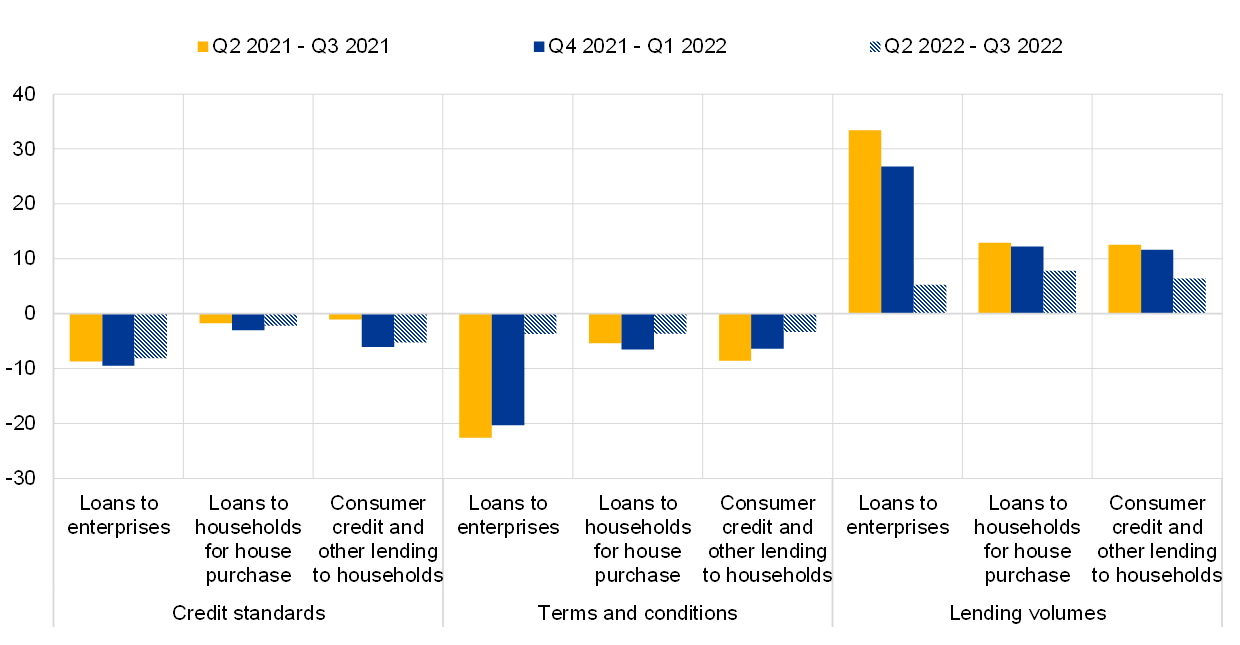
Notes: Net percentages are defined as the difference between the sum of the percentages for “contributed considerably to a tightening or increase” and “contributed somewhat to a tightening or increase” and the sum of the percentages for “contributed somewhat to an easing or decrease” and “contributed considerably to an easing or decrease". The last period denotes expectations indicated by banks in the current round.
A large net percentage of euro area banks continued to report a positive impact of TLTRO III on their lending volumes to enterprises over the past six months (net percentage of 27%, after 33%; see Chart 25). Banks continued to report a positive impact of TLTRO III also for lending volumes to households for house purchase (net percentage of 12%, after 13%) and for consumer credit (12%, after 13%).
Over the coming six months, banks expect a more limited net easing impact of TLTRO III on terms and conditions, and a more limited positive net impact on lending volumes across all loan categories compared with the past six months. The expected impact on terms and conditions and loan volumes is less pronounced than over the past six months, in particular for loans to firms for which the impact has been the strongest in the past. This potentially reflects the fact that TLTRO liquidity is expected to decline over this horizon. At the same time, banks expect a moderate further easing impact on credit standards, close to that reported for the past six months.
Annexes
See more.
© European Central Bank, 2022
Postal address 60640 Frankfurt am Main, Germany
Telephone +49 69 1344 0
Website www.ecb.europa.eu
All rights reserved. Reproduction for educational and non-commercial purposes is permitted provided that the source is acknowledged.
For specific terminology please refer to the ECB glossary (available in English only).
PDF ISSN 1830-5989, QB-BA-22-002-EN-N
HTML ISSN 1830-5989, QB-BA-22-002-EN-Q
- The four largest euro area countries in terms of GDP are Germany, France, Italy and Spain. From the April 2022 BLS onwards, banks are asked about additional factors having an impact on the terms and conditions for loans to firms and on credit standards for loans to households, as well as about the developments – across firm sizes – in the factors having an impact on loan demand and the share of rejected loan applications. In addition, since the January 2022 BLS onwards, the aggregation of banks’ replies to the euro area results has been based on unweighted national results for all countries.
- For more detailed information on the bank lending survey, see the article entitled “A bank lending survey for the euro area”, Monthly Bulletin, ECB, April 2003; Köhler-Ulbrich, P., Hempell, H. and Scopel, S., “The euro area bank lending survey”, Occasional Paper Series, No 179, ECB, 2016; and Burlon, L., Dimou, M., Drahonsky, A. and Köhler-Ulbrich, P., “What does the bank lending survey tell us about credit conditions for euro area firms?”, Economic Bulletin, Issue 8, ECB, December 2019.
- To ensure a good representation of national bank lending markets, the selected sample banks are generally of similar size or have lending behaviour that is typical of a larger group of banks.
- The non-harmonised historical data differ from the harmonised data mainly as a result of heterogeneous treatment of “NA” (Not Applicable) replies and specialised banks across questions and countries. Non-harmonised historical BLS data are published for discontinued BLS questions and ad hoc questions.
- In this survey round, banks provided additional information on the impact of the war in Ukraine on their credit standards and demand for loans to enterprises, and the main contributing factors.
- The European Systemic Risk Board recommended in December 2021, among other things, the introduction of a limit on the loan-to-value ratio, the activation of capital-based measures and the activation of income-related borrower-based measures with regard to the German residential real estate sector. The Federal Financial Supervisory Authority (Bundesanstalt für Finanzdienstleistungsaufsicht – BaFin) introduced higher capital buffer requirements for the German real estate sector in April 2022 (see also the official publication in German).
- The fact that overall terms and conditions tightened in France while margins narrowed (representing an easing) and all other components remained broadly unchanged reflects the fact that some banks highlighted margins narrowing mechanically on account of higher funding costs, with banks counteracting this easing of conditions at the same time.
- Net interest income is defined as the difference between the interest earned and interest paid by the bank on the outstanding amount of interest-bearing assets and liabilities.
- Banks which participated in the respective operation under the TLTRO III programme are asked about the reasons for participation and can indicate more than one reason. The reported percentage share refers to all banks.
- This results from comparing the net percentages with the respective participation rates based on weighted net percentages.
- 12 April 2022


